Schneider Shorts of 22 March 2023 – honesty researcher faces the sack, misconduct charges lifted in Norway, misconduct charges in Sweden, with anti-canadian xenophobia, publishers showing understanding for all kinds of fraud, and finally, with anti-aging advice for dogs and men.
Table of Discontent
Science Elites
- Firing Francesca Gino – Harvard investigation proves it’s bad idea to sue your university
- Stop posting non-peer-reviewed and unauthenticated false color images – Jack Jhamandas cures Alzheimer’s
- Striving for truth, quality and honesty – wrongly accused Jian Wang gets justice in Norway
- A wasting of time for the authors and discredit pubpeer – Myriam Aouadi guilty of misconduct in Sweden
Scholarly Publishing
- Judged this to be satisfactory – BMJ believes Massimo Pignatelli and Christos Paraskeva
- An error in the compilation – EMBO member Kristian Helin benefits from special rule
- Correction seems like the right approach – Wiley optimistic about fake spectra by Hermenegildo Garcia
- This will be processed and published – Elsevier editor Bill Nimmo helps papermillers
Industry Giants
- The textbook definition of snake oil salesman – David Sinclair opens new business, upsets envious peers
Science Breakthroughs
- Try to maximize my longetivity – Matt Kaeberlein and Eric Verdin push rapamycin in WaPo
- Long-term consequences for our bodies – Kiwi scientists blame your wife
Science Elites
Firing Francesca Gino
The case of the honesty researcher and litigious Harvard professor Francesca Gino is close to its expected conclusion. The student newspaper The Harvard Crimson brought on 15 March 2024 the headline:
“Harvard Business School Investigation Report Recommended Firing Francesca Gino“
She has been on administrative leave since June 2023. From Harvard Crimson:
“An internal report from the Harvard Business School revealed that the faculty committee charged with leading the investigation into allegations of data fraud against professor Francesca Gino found her responsible for the alleged misconduct and recommended her termination.
The report, a nearly 1,300-page document detailing the Business School’s process for investigating allegations of research misconduct against faculty members, became public after a federal judge ordered it unsealed in a ruling on Tuesday. […]
The document was produced by three HBS faculty members and lies at the heart of a $25 million defamation lawsuit filed by Gino against Harvard over its investigation into the data fraud allegations. […]
Data Colada — a data investigation blog run by three business school professors that first publicly accused Gino of data fraud in a series of posts in June — said it contacted HBS about Gino’s alleged misconduct in fall 2021. The internal report revealed that around the same time, on Oct. 12, 2021, the school received an anonymous complaint against Gino, also alleging research misconduct. […]
The committee also recommended that [HBS Dean Srikant] Datar immediately place Gino on unpaid leave and initiate proceedings to terminate her from the University. […]
The investigation concluded that Gino had “significantly departed from accepted practices of the relevant research community and committed research misconduct intentionally, knowingly, or recklessly.”
In addition to the sanctions against Gino, the report also recommended an audit of “other published empirical studies by Professor Gino, beyond the four studies at issue in these allegations.”

Gino (who also sued the Data Colada bloggers) fought against her investigators like a lion:
“The report says that Gino asserted that “an unknown actor with malicious intentions was a more plausible explanation than honest errors or intentional data falsification by herself.”
The report says that Gino named a professor who collaborated with her on several research projects as the person she believed intentionally falsified her data.
While the professor’s name was redacted from the public copy of the report, the person was identified as a female co-author on a 2012 study published in the Proceedings of the National Academy of Sciences, a peer-reviewed journal. That article has since been retracted and is among the four papers in which Gino has been accused of committing data fraud.”
The accused was the Boston University professor Nina Mazar (a 19 March 2024 Harvard Crimson article confirmed it):
Lisa L. Shu, Nina Mazar, Francesca Gino, Dan Ariely, and Max H. Bazerman, Signing at the beginning makes ethics salient and decreases dishonest self-reports in comparison to signing at the end Proc. Natl. Acad. Sci. U.S.A. (2012) doi: 10.1073/pnas.1209746109 Retraction Sept 2021, doi: 10.1073/pnas.2115397118
According to WSJ, “Harvard and Data Colada will make arguments to dismiss Gino’s claims at a hearing scheduled for April 26.” The Data Colada bloggers raised $400k of donations in their legal defence fund against Gino. She is unlikely to win now, but chances are high this internationally acclaimed honesty expert will bugger off to Italy and won’t even pay her own lawyers.
Gino’s partner-in-fraud and Duke University professor Dan Ariely (read here) still prances around pretending to be an innocent victim of envy against his genius.

Stop posting non-peer-reviewed and unauthenticated false color images
Meet Jack Jhamandas, professor of neurology at the University of Alberta in Canada. This doctor in is his seventies, but still has no plans to retire, presumably until he finally cures Alzheimer’s. And he is almost there!
Now meet Dr Jhamandras’ newly established PubPeer record, courtesy of Cheshire.
Jack H. Jhamandas, Caroline Cho , Balvinder Jassar , Kim Harris , David MacTavish , Jacob Easaw Cellular Mechanisms for Amyloid β-Protein Activation of Rat Cholinergic Basal Forebrain Neurons Journal of Neurophysiology (2001) doi: 10.1152/jn.2001.86.3.1312
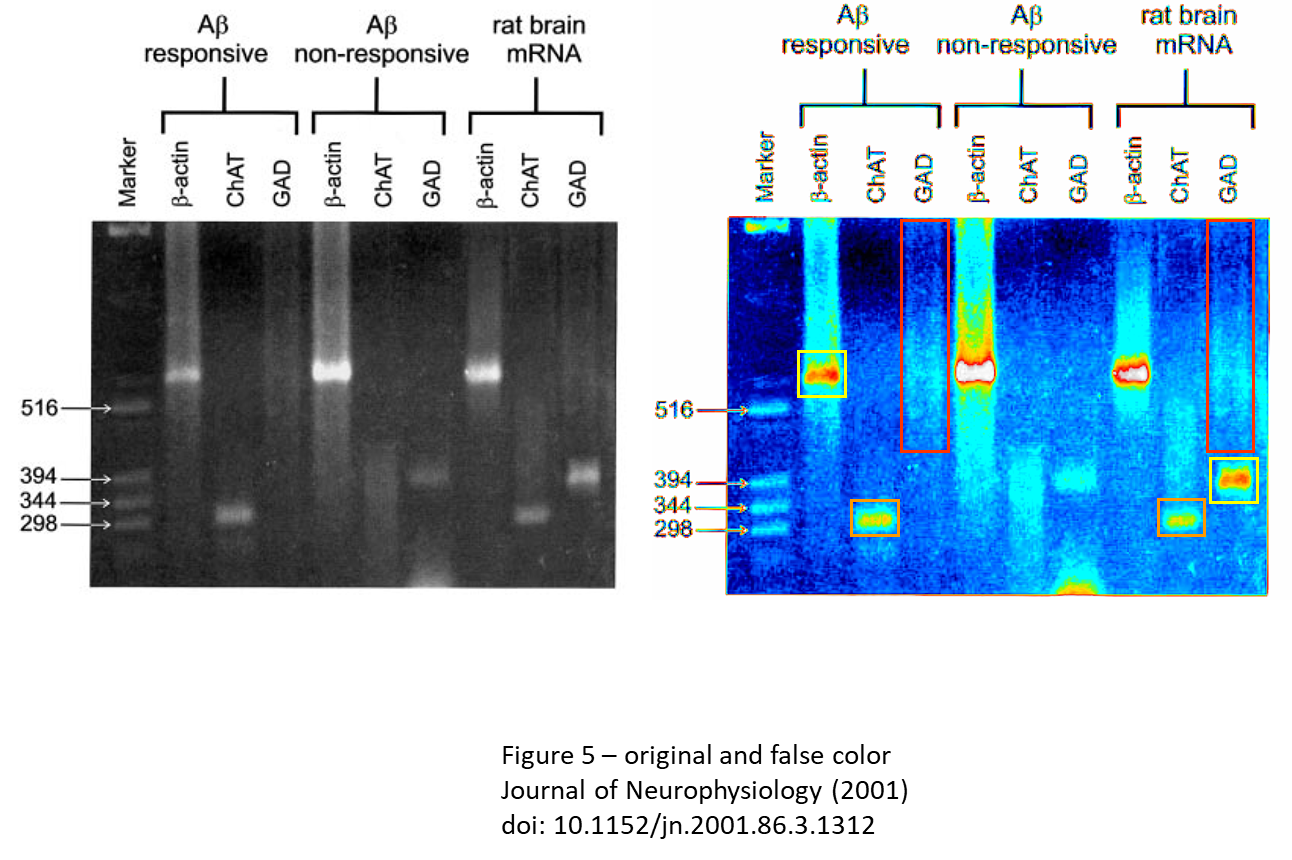
Now, when this paper was published, the first author Jhamadras was already full professor and a Canada Research Chair in Alberta, roughly in his fifties. If he wished to assert that he personally stood in the lab and did all those experiments, so be it. Because the gel is fake. But Jhamadras replied on PubPeer with:
“I think you need to stop posting non-peer-reviewed and unauthenticated false color images of the data and drawing conclusions that are not supported by the peer reviewed data in good journals.“
Right-ho. I wrote to Jhamadras, and he changed his tune:
“this paper was published 24 years ago in an era where we had to submit paper copies and there were no sophisticated electronic tools. As the lead and first author, I fully stand by the data and the conclusions we published in that manuscript.”
Really? Any Canadians around? Did you have computers and internet in 2001 like we all others? In 2011, now in his sixties, Professor Jhamandas went to the lab again to swing a pipette:
Jack H. Jhamandas, Zongming Li , David Westaway, Jing Yang , Simran Jassar , David MacTavish Actions of β-amyloid protein on human neurons are expressed through the amylin receptor American Journal Of Pathology (2011) doi: 10.1016/j.ajpath.2010.11.022 Fig 6, duplicated gel with different exposure
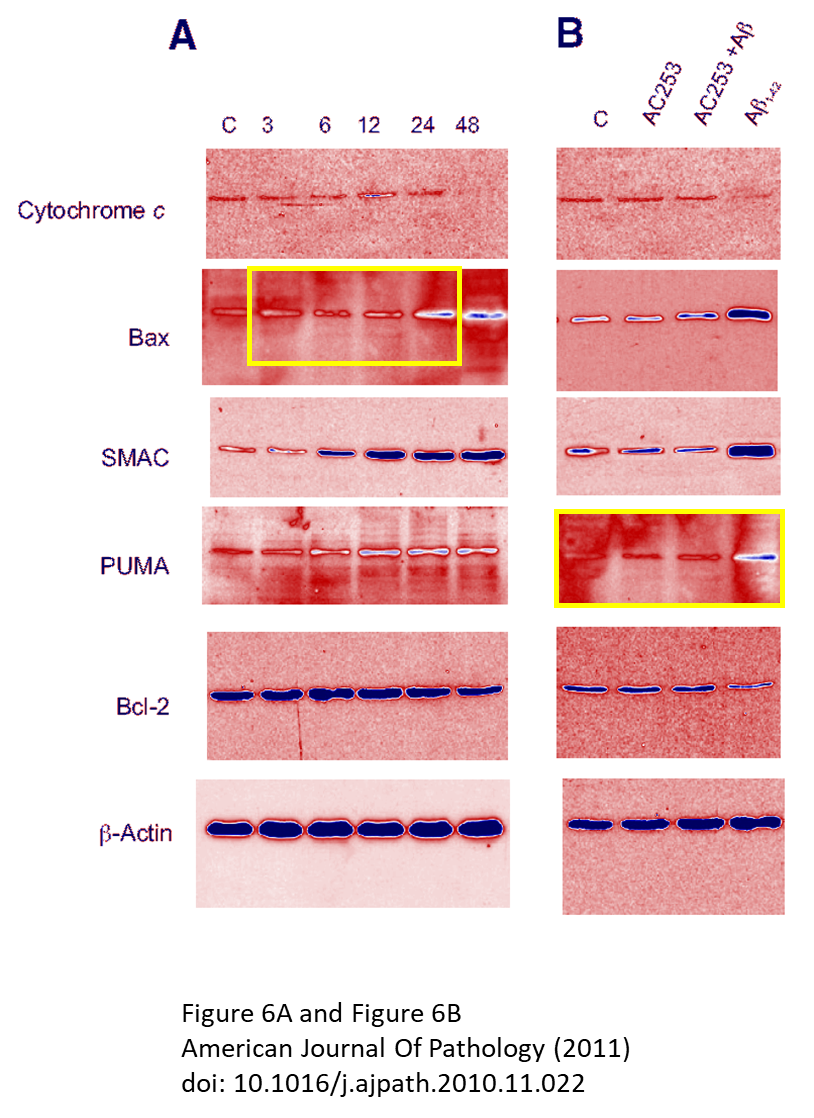
On PubPeer, Jhamandas denied that the two gels were surprisingly similar, and protested against criticism of Canadian Alzheimer’s research:
“We have a long record of publications in good journals and we pride ourselves on our honest, integrity and commitment to ethical behavior. I am all for peer review and post-mortems on PubPeer, but I am troubled that PubPeer would let this type of xenophobic comments get a forum on a site that promotes discussion of science- good or bad.“
Xenophobic comments against Canadians? Jhamandas also protested against the sharing of his past Errata on PubPeer, specifically for Soudy et al 2019 where “the control trace for both the HEK-AMY3 and HEK-WT cells was duplicated“.
Here, a loading control used 3 times in 3 different experiments:
Aarti Patel , Vishnu Vasanthan , Wen Fu , Richard P Fahlman , David MacTavish , Jack H Jhamandas Histamine induces the production of matrix metalloproteinase-9 in human astrocytic cultures via H1-receptor subtype Brain Structure and Function (2016) doi: 10.1007/s00429-015-1007-x
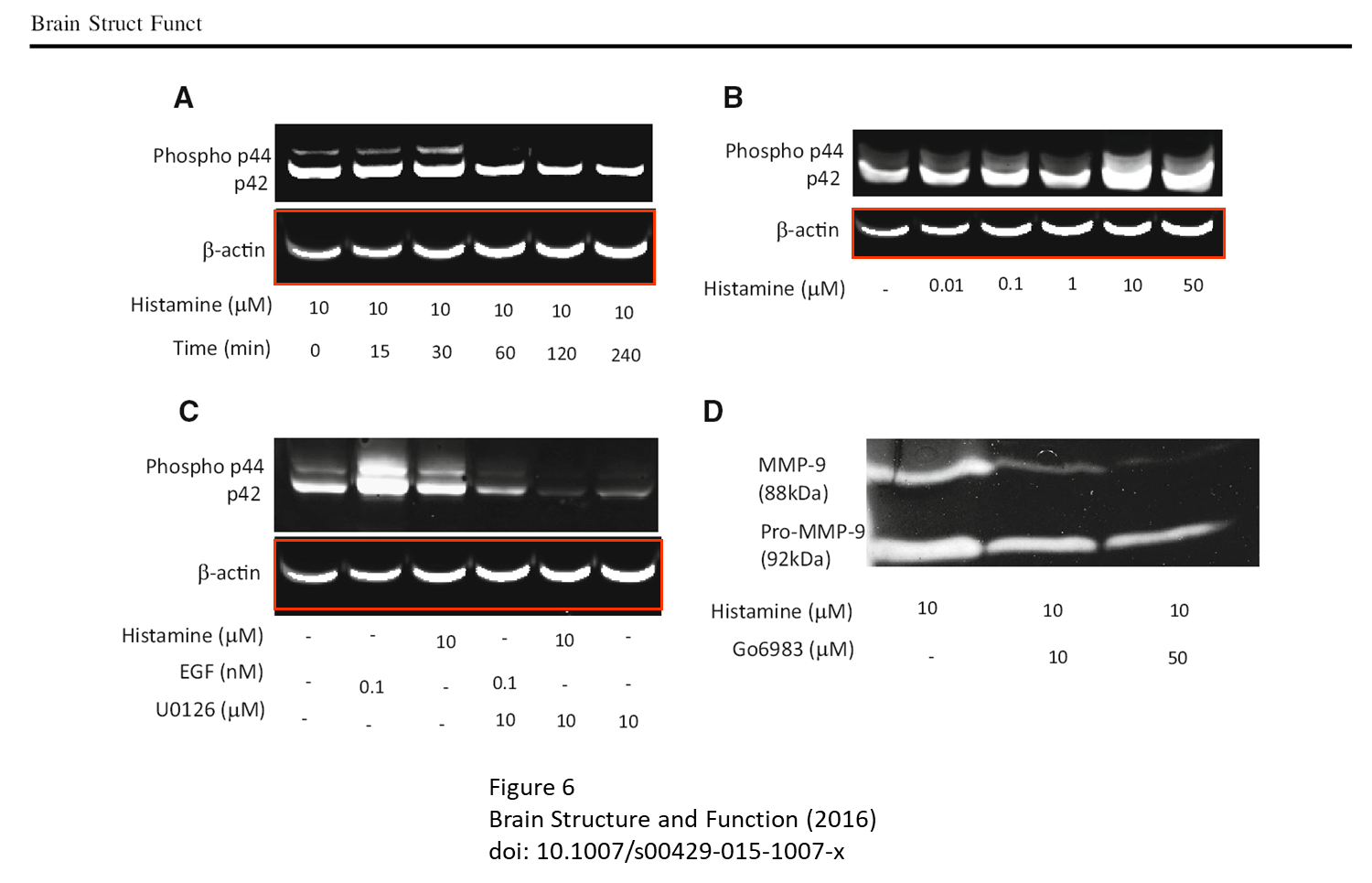
Jharmandas apologised for the error, provided replacement actin gels (which don’t really fit), and declared that his “revision does not change the interpretation of the data in this figure or the conclusions in the manuscript.” There are other papers which Jhamandas hasn’t yet commented upon:
C. Hawkes , J. H. Jhamandas, S. Kar Selective loss of basal forebrain cholinergic neurons by 192 IgG‐saporin is associated with decreased phosphorylation of Ser9 glycogen synthase kinase‐3β Journal of Neurochemistry (2005) doi: 10.1111/j.1471-4159.2005.03363.x
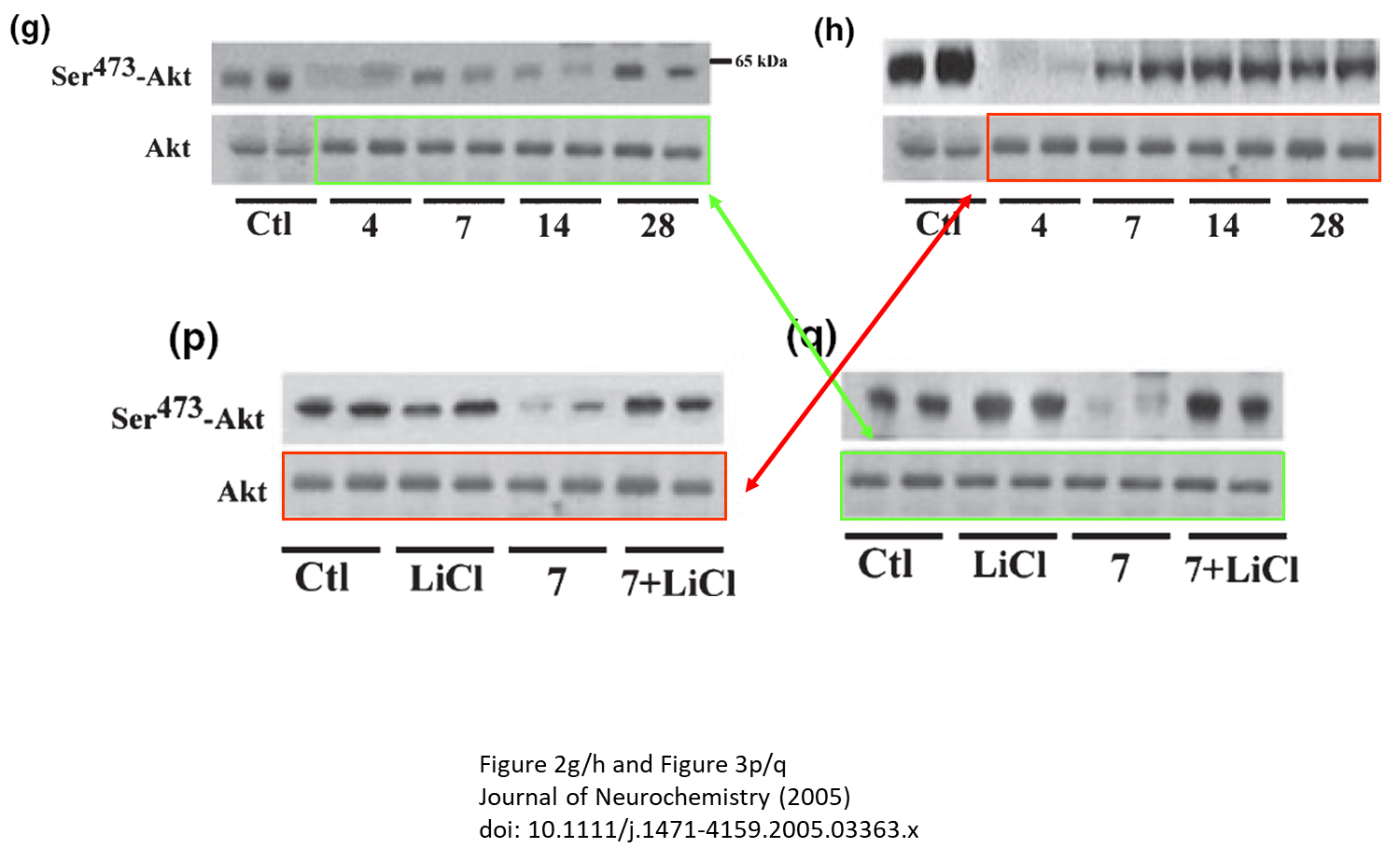
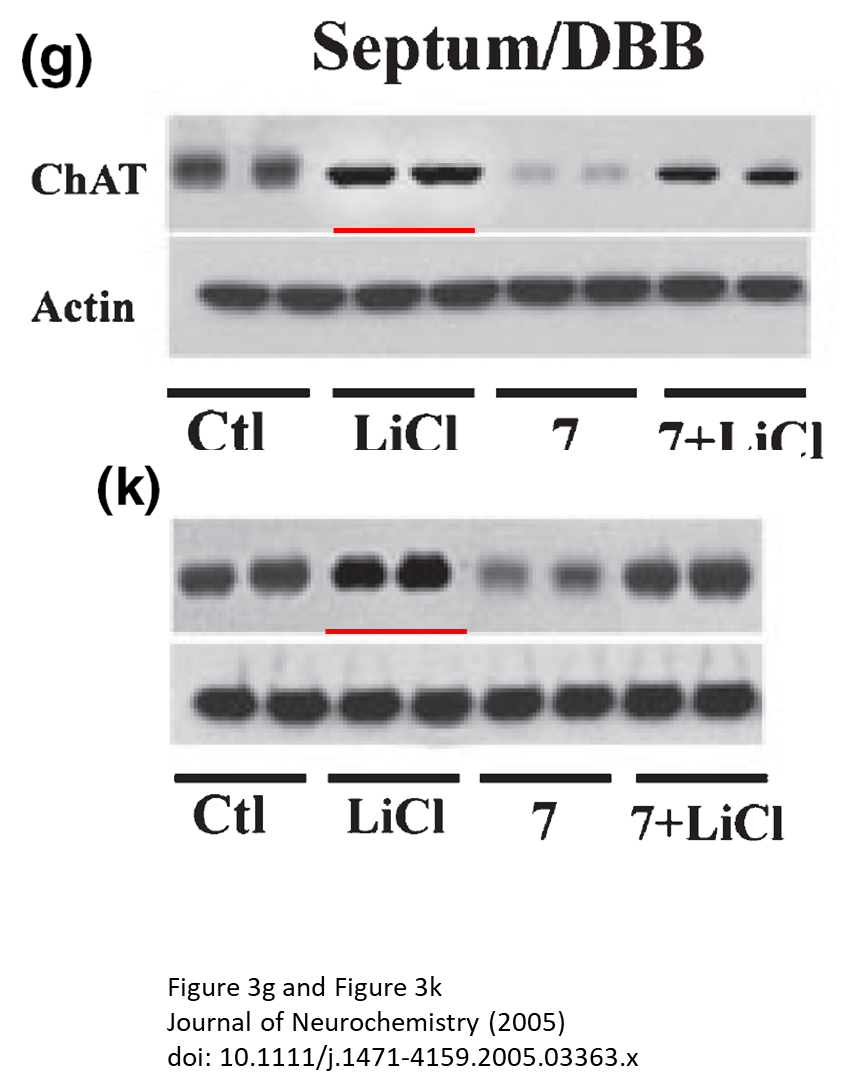
This can’t be criticised because it passed peer review many years ago, yet the naughty duplication is very difficult to explain:
Krukoff, MacTavish , Jhamandas Effects of Restraint Stress and Spontaneous Hypertension on Neuropeptide Y Neurones in the Brainstem and Arcuate Nucleus Journal of Neuroendocrinology (1999) doi: 10.1046/j.1365-2826.1999.00391.x
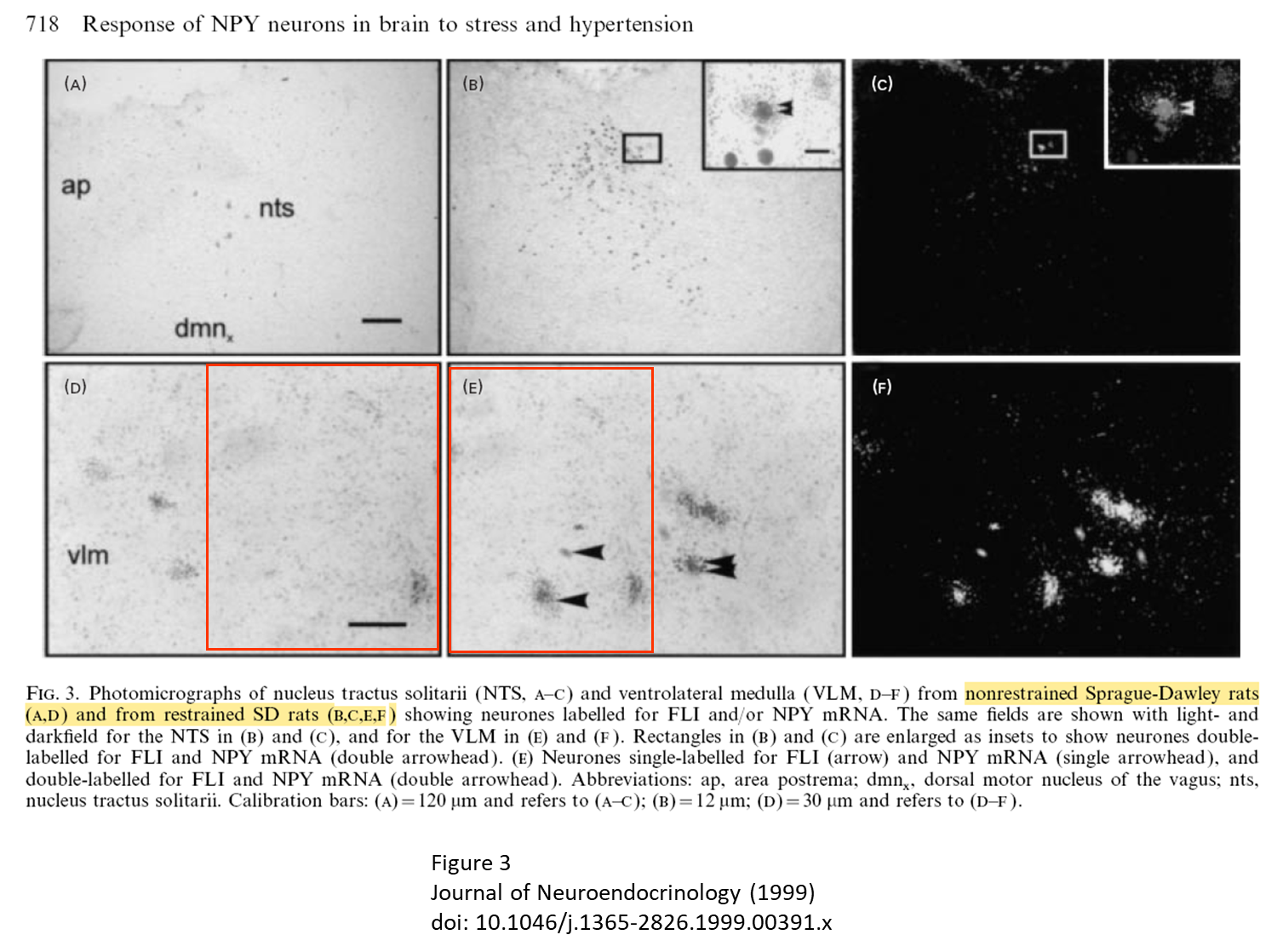
You heard Professor Jhamandas. Back then, image processing technology was not invented yet. So the images just look near-identical.
Striving for truth, quality and honesty
In early 2023, the cancer research professor Jian Wang of the University of Bergen in Norway was found guilty of research misconduct by gross negligence over data manipulations in his papers. He then appealed and won, the misconduct findings were overthrown. Now a sleuth found even more fraud in Wang’s science.
The communal misconduct by Zhenhe Suo in Olso
“the Committee believes that when carelessness or scientific dishonesty can be found in so many articles with so many different authors in question, there must be a lack of training and / or lack of control over data handling. The committee therefore believes that it is qualified probability that there has been an institutional system…
On 2 February 2023, the Norwegian newspaper Khrono reported (Google-translated):
“It was in March 2021 that the integrity committee at the University of Bergen (UiB) received a message of concern. It was alleged reuse of data, manipulation of images or suspicious repetition of statistical data in a total of nine scientific articles that employees and a former employee at the Faculty of Medicine had contributed to. […]
It was students and PhD candidates in China who had made the mistakes, according to him. He was responsible for following up on these.
The experiments described in the articles were carried out in a laboratory in China, such as the University in Bergen collaborates with a Chinese university on. The professor was a supervisor for PhD students here, and had overall responsibility for the collaboration. He has divided the position, 50 per cent in Norway and 50 per cent in China. […]
The integrity committee at the University of Bergen concluded in November that the professor has “violated recognized research ethics norms in his roles as project manager, supervisor and co-author.” They indicate that there are violations of different kinds in all nine articles. […]
The committee writes that they have no information indicating that the professor has acted intentional, but believes he has acted grossly negligently, and thus scientifically fraudulent.”
The unnamed professor was Wang. Some of his work was later retracted, for example this:
Chao Zhang , Xin Zhang , Ran Xu , Bin Huang , An-Jing Chen , Chao Li , Jian Wang , Xin-Gang Li TGF-β2 initiates autophagy via Smad and non-Smad pathway to promote glioma cells’ invasion Journal of Experimental & Clinical Cancer Research (2017) doi: 10.1186/s13046-017-0628-8
Retraction from December 2021 mentioned “the authors have stated they found some additional errors in Figs 5c, 5d and 5j.“
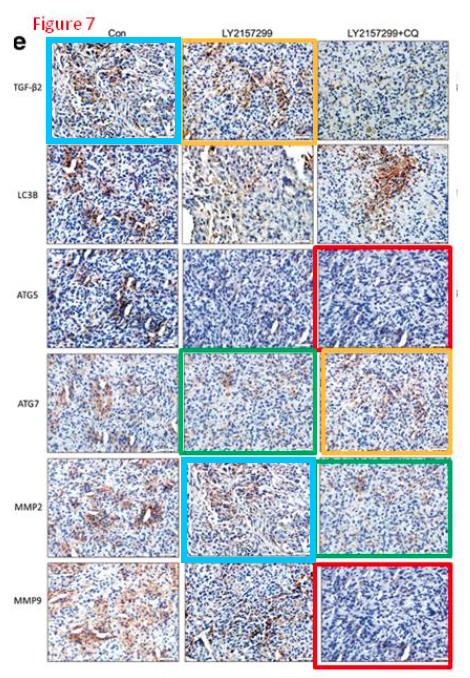
But then Wang deployed lawyers. On 18 September 2023, Khrono brought an update (translated):
“The professor has indeed broken recognized scientific norms, believes the Investigation Committee, which is a national appeals body in cases of scientific misconduct. But it ends up with a milder “judgment” than the local integrity committee that dealt with the case first. […]
In discussing his role as co-author, the Committee refers to the Vancouver guidelines. It is established that all co-authors are responsible for investigating possible errors. But the Investigation Committee shows that in interdisciplinary research co-researchers do not always have the expertise to to assess what others are doing, and “there must be a certain amount of room” for one to be able to trust each other. It is also complicated to scrutinize the images, states the committee.
The professor was also the project manager. The committee writes that it is not a project manager’s job to control all work at a detailed level. […]
The investigation committee nevertheless believes that he has broken recognized research ethics norms, but that this does not qualify as scientific misconduct.
“The falsification of images is a violation of the norms about striving for truth, quality and honesty. Complainant has acted negligently, but not grossly negligent. Consequently, he has not acted scientifically fraudulently”, says the statement.”
The University of Bergen was specifically blamed for not teaching Wang his responsibilities.
Like all professors, Wang was employed by his university to publish papers, not to read them. Therefore, his specific duty was to take credit for the fraudulent papers he mass-produces in China in order to defraud Norwegian public out of salary and research money. And this was exactly what Wang continued with, while the investigation circus ran, and even after it ended with his acquittal.
Anbin Chen , Cecilie Katrin Kristiansen , Yu Hong , Atefeh Kianian , Evandro Fei Fang , Gareth John Sullivan , Jian Wang , Xingang Li , Laurence A. Bindoff , Kristina Xiao Liang Nicotinamide Riboside and Metformin Ameliorate Mitophagy Defect in Induced Pluripotent Stem Cell-Derived Astrocytes With Mutations Frontiers in Cell and Developmental Biology (2021) doi: 10.3389/fcell.2021.737304
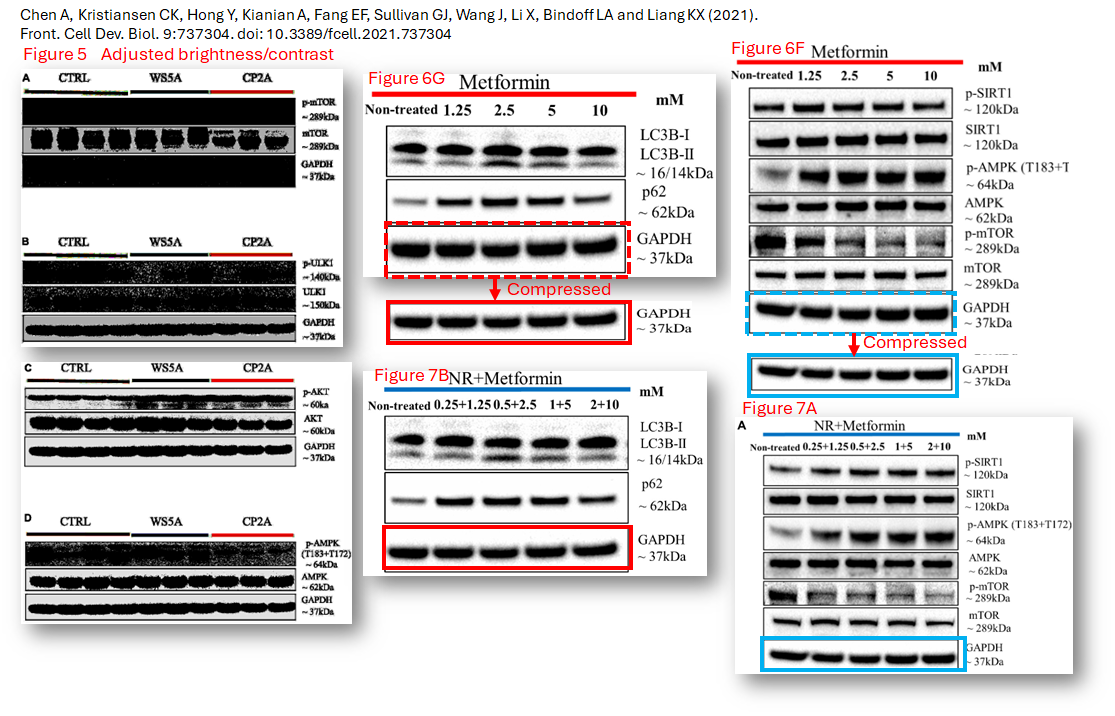
“In Figure 5, several Western immunoblots have no background staining (noise), and are very different compared to the corresponding blots. This is seen by adjusting the brightness/contrast as shown.
In Figure 6G and 7B, the loading control (GAPDH) has been duplicated, manipulated and presented differently.
In Figure 6F and 7A, the loading control (GAPDH) has been duplicated, manipulated and presented differently.”
What? Did you expect Wang to stop? But he is officially innocent, acquitted of research fraud in all of his Chinese papers in the past, the future, and in perpetuity!
Zhiyi Xue, Yan Zhang , Ruiqi Zhao, Xiaofei Liu, Konrad Grützmann, Barbara Klink , Xun Zhang, Shuai Wang , Wenbo Zhao, Yanfei Sun, Mingzhi Han, Xu Wang, Yaotian Hu , Xuemeng Liu, Ning Yang , Chen Qiu, Wenjie Li, Bin Huang, Xingang Li , Rolf Bjerkvig, Jian Wang, Wenjing Zhou The dopamine receptor D1 inhibitor, SKF83566, suppresses GBM stemness and invasion through the DRD1-c-Myc-UHRF1 interactions Journal of Experimental & Clinical Cancer Research (2024) doi: 10.1186/s13046-024-02947-7
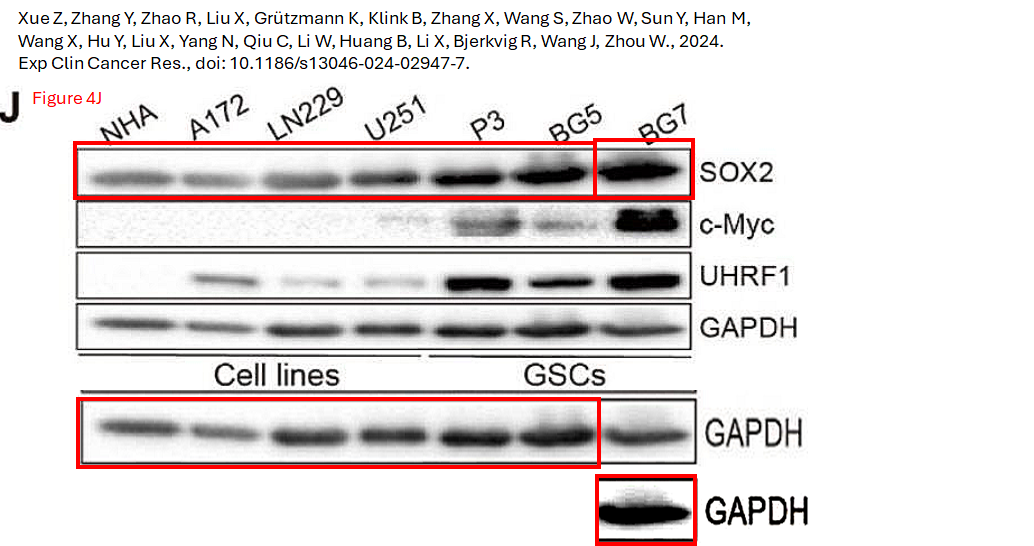
Indigofera tanganyikensis: “In Figure 4J, the Sox2 and GAPDH Western immunoblots are more similar than one would expect.”
Here is the full list of Wang’s problematic papers, with links to PubPeer evidence by Indigofera tanganyikensis:
A wasting of time for the authors and discredit pubpeer
In Sweden, the National Board for Assessment of Research misconduct (NPOF) made another verdict against four researchers of Karolinska Institutet (KI) who were found “guilty of research misconduct”:
- Myriam Aouadi, former award-winning senior researcher at KI, who in 2020 received a €1.3 million grant from Novo Nordisk
- Valerio Azzimato, former KI researcher, since 2023 senior scientist at AstraZeneca
- Laura Levi, lab manager at KI
- Cecilia Morgantini, research affiliate at KI
The original Swedish version of the report is available here:
From the NPOF verdict:
“On March 25, 2022, Karolinska institutet (KI) submitted a case of alleged research misconduct to the Board. […] The research concerns liver disease in overweight individuals with pre-stage or developed type 2 diabetes. It has been conducted at the Integrated Cardio Metabolic Centre, ICMC, which is a research center jointly founded by KI and AstraZeneca. The submission concerns suspicions of falsification and fabrication of data underlying three articles.”
These were the 3 papers. Article 1 was about targetting miR-144 for diabetes and obesity therapy, the declared Conflicts of Interests were: “Volker M. Lauschke is founder, CEO, and shareholder of HepaPredict AB, and performs consultancy work for EnginZyme AB. The remaining authors disclose no conflicts.”
- Valerio Azzimato, Ping Chen , Emelie Barreby , Cecilia Morgantini , Laura Levi , Ana Vankova , Jennifer Jager , André Sulen , Marina Diotallevi , Joanne X. Shen , Anne Miller , Ewa Ellis , Mikael Rydén , Erik Näslund , Anders Thorell , Volker M. Lauschke , Keith M. Channon , Mark J. Crabtree , Arvand Haschemi , Siobhan M. Craige , Mattia Mori, Francesco Spallotta, Myriam Aouadi Hepatic miR-144 Drives Fumarase Activity Preventing NRF2 Activation During Obesity Gastroenterology (2021) doi: 10.1053/j.gastro.2021.08.030
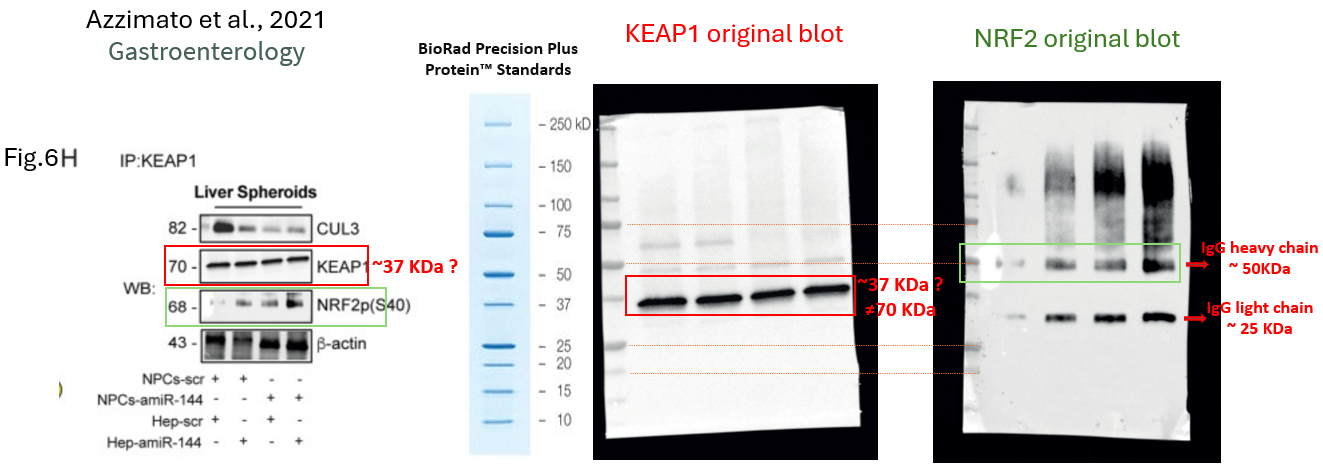
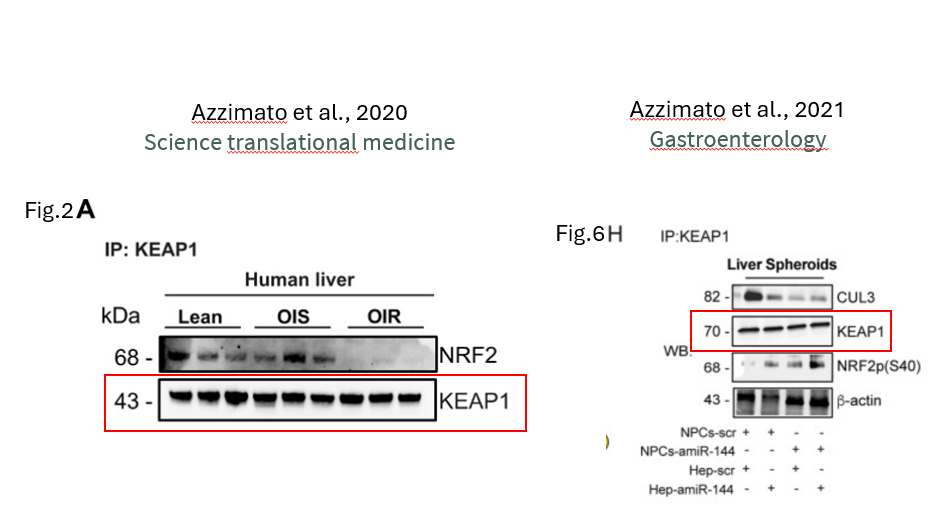
In August 2022, that paper was corrected:
“…the actin did not correspond to the IRG1 membrane displayed in Figure 1F. The western blot images used in Figure 1F have been updated to reflect IRG1 expression and its loading control, actin, hybridized to the same membrane. The corrections noted in this erratum do not affect any of the original conclusions.”
But the correction was not honest:
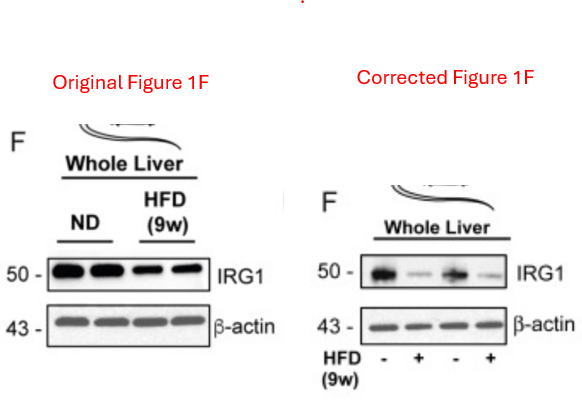
Conus proximus: “both blots for IRG1 and β-actin were replaced, not only the β-actin blot. If the β-actin did not correspond to the IRG1 membrane displayed, why then were both membranes replaced, not only the erroneous β-actin membrane?“
A number of other issues were found in that paper, as discussed on PubPeer.
Article 2 was also about targetting miR-144 for diabetes and obesity therapy, it was published before the COI-free Azzimato et al 2021, but back in 2020 Azzimato and Aouadi were slightly more honest about their financial COI: “V.A. and M.A. are inventors of a pending filing patent application (UK1910299.5, “Medical uses, methods, and uses”) through Potter Clarkson LLP.”
- Valerio Azzimato , Jennifer Jager , Ping Chen, Cecilia Morgantini , Laura Levi , Emelie Barreby, André Sulen , Carolina Oses , Joost Willerbrords , Connie Xu , Xidan Li , Joanne X. Shen , Naveed Akbar , Lars Haag , Ewa Ellis , Kerstin Wålhen , Erik Näslund, Anders Thorell , Robin P. Choudhury, Volker M. Lauschke, Mikael Rydén, Siobhan M. Craige, Myriam Aouadi Liver macrophages inhibit the endogenous antioxidant response in obesity-associated insulin resistance Science Translational Medicine (2020) doi: 10.1126/scitranslmed.aaw9709
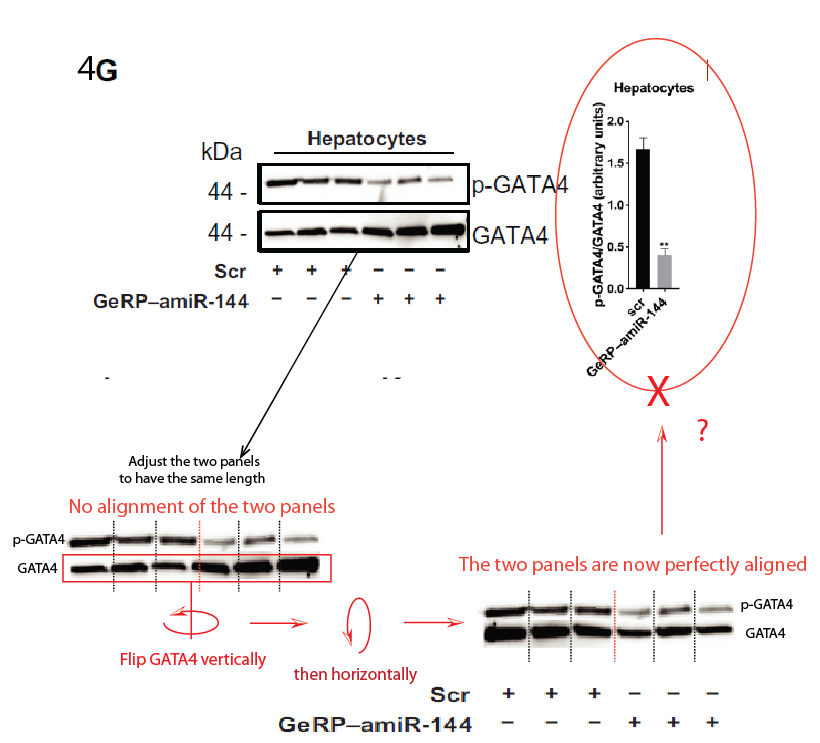
Spratelloides gracilis: “In figure 4G, the GATA4 panel seems to have been vertically and horizontally flipped. This would change the order of the scramble and GeRP-amiR-144 groups and, therefore, the plotted difference of p-GATA4 in the barplot would no longer be valid. The correct alignment may only show a difference in GATA 4 amounts between the two groups if the samples loading were equal.”
Article 2 was exempted from the investigation:
“The same article has previously been tried by the Board in case 3.1-20/0059. The Board will therefore not try the article again.”
Article 3, a study related to the later miRNA-144 work, was declared as completely COI-free for all authors. It was corrected in January 2021 with “in Fig. 4c, the y-axis units read ‘mg/dl’ but should have read ‘percent baseline’.” On 21 December 2022, Editor’s Note was issued: “Readers are alerted that the reliability of data presented in this article is currently in question. Appropriate editorial action will be taken once this matter is resolved”
- Cecilia Morgantini, Jennifer Jager, Xidan Li , Laura Levi , Valerio Azzimato , André Sulen , Emelie Barreby, Connie Xu , Michaela Tencerova, Erik Näslund, Chanchal Kumar , Francisco Verdeguer , Sara Straniero, Kjell Hultenby , Niklas K. Björkström, Ewa Ellis , Mikael Rydén, Claudia Kutter, Tracey Hurrell , Volker M. Lauschke, Jeremie Boucher, Aleš Tomčala, Gabriela Krejčová, Adam Bajgar, Myriam Aouadi Liver macrophages regulate systemic metabolism through non-inflammatory factors Nature Metabolism (2019) doi: 10.1038/s42255-019-0044-9

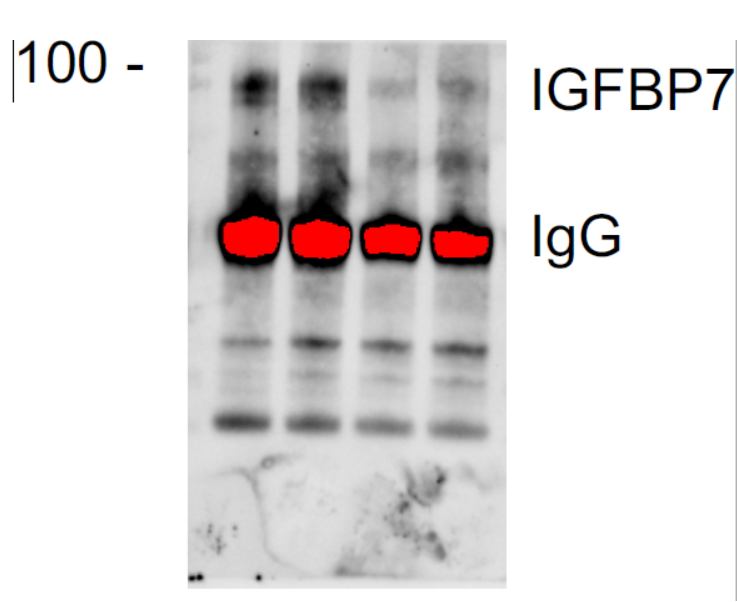
Oncaea borealis: “The main protein discussed in this paper is Igfbp7. According to UniProt, Igfbp7 protein has two isoforms with 281 and 313 amino acids, corresponding to a molecular weight of ~29 KDa. However, the author reported a completely different protein at ~70 KDa as a band for Igfbp7 in all figures of western blot and IP (figure 2c, 5c,5f,5l, S2a &S5c). How could this be possible? “
PubPeer moderators received this message (likely from Aouadi), which they made public:
“The person writing this further comment is posting our figures partly cut and this is misleading the reader of pubpeer. Indeed, in our original figures , it is clearly written IP (immunoprecipitation). The technical procedure is cited in the figure legends and explained in the method section. Hence, the comment is not relevant. In the previous comment, not only he/she is expressing general concerns (already reported) but also asking for raw data of mitochondrial quantification which is not even something shown in our paper (the figure cited is showing cellular lipid droplet). It seems that the person has not read the paper carefully. I believe that this kind of comments are not making any improvement to the scientific discussion, are a wasting of time for the authors and discredit pubpeer. I hope that you would consider deleting both comments.”
And indeed, the external expert tasked by NPOF with investigating this case, the Örebro University professor Tuulia Hyötyläinen, agreed! From the report:
“The expert’s assessment is that there are no grounds for any of the allegations of falsification and fabrication. She summarizes that there are some mistakes in the articles, but they are minor and have had no, or very little, impact on the results. The allegations point to some well-known challenges associated with WB analysis, and although she believes that there could have been good reasons to further attempt to verify the results, she does not consider this cause for allegations of research misconduct but rather a matter for scientific discussion. She also argues that the authors have provided credible explanations and responses to the allegations. Regarding the WB panels that the complainant claims have been inaccurately reused, the expert believes that it cannot be known for certain without further image analysis but points out that there is no apparent motivation to reuse WB panels in the alleged manner and that quantitative data, not the images displayed, have been used in the analysis. Therefore, she considers further image analysis unnecessary.”
Data manipulation evidence in Helin Vakifahmetoglu papers “warrants no further consideration”
The Swedish Karolinska Institutet (KI) has investigated its own cell biologist and well-funded autophagy researcher Helin Vakifahmetoglu-Norberg, following my publishing of a dossier with evidence for data manipulations in her papers. Also PubPeer evidence was considered. This was a second investigation of Vakifahmetoglu-Norberg, who was fully acquitted by KI already in 2016. While the new KI…
NPOF however disagreed with its own expert and decided the concerns were valid enough to slap Aouadi and her colleagues with research misconduct findings. NPOF determined:
“The Board finds that figures 1F and 6H in article 1, and figures 5C, 5D, 5F, 5G, 5I, 5K, S2A, and S5C in article 3 are falsified.”
As for responsibility, only Sweden-affliated authors were investigated:
“In summary, the Board finds that Myriam Aouadi, Valerio Azzimato, Laura Levi, and Cecilia Morgantini have committed research misconduct in articles 1 and 3. The Board concludes that Emelie Barreby, Niklas Björkström, Jeremie Boucher, Ping Chen, Ewa Ellis, Kjell Hultenby, Tracey Hurrell, Claudia Kutter, Volker Lauschke, Xidan Li, Erik Näslund, Mikael Rydén, Joanne Shen, Sara Straniero, André Sulen, and Anders Thorell have not committed research misconduct.”
Here is the English translation of NPOF decision:
Dodgy science was Aouadi trademark already as PhD student at the University of Nice in France. Here some stealthily spliced gels:
Myriam Aouadi , Kathiane Laurent , Matthieu Prot , Yannick Le Marchand-Brustel , Bernard Binétruy , Frédéric Bost Inhibition of p38MAPK Increases Adipogenesis From Embryonic to Adult Stages Diabetes (2006) doi: 10.2337/diabetes.55.02.06.db05-0963
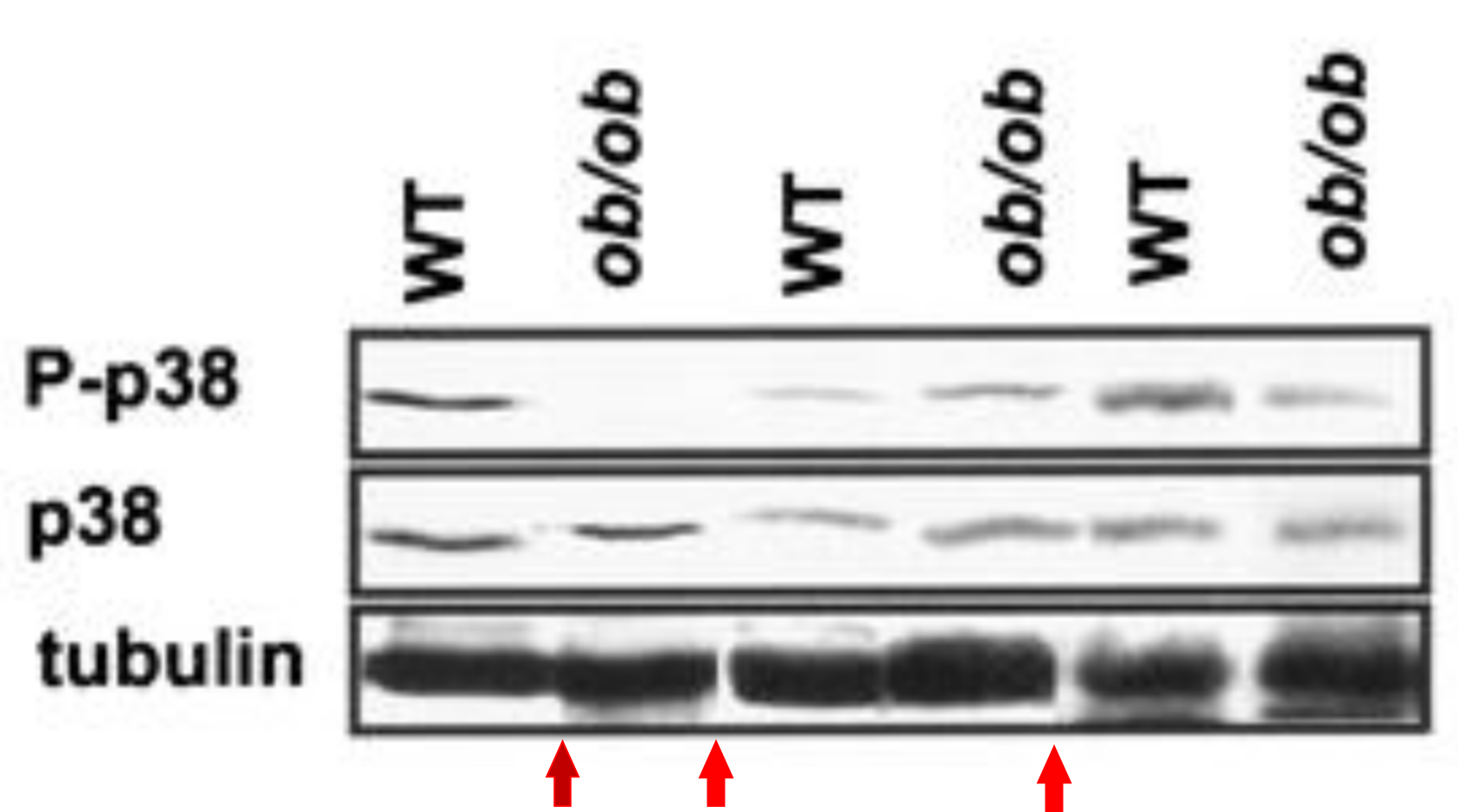

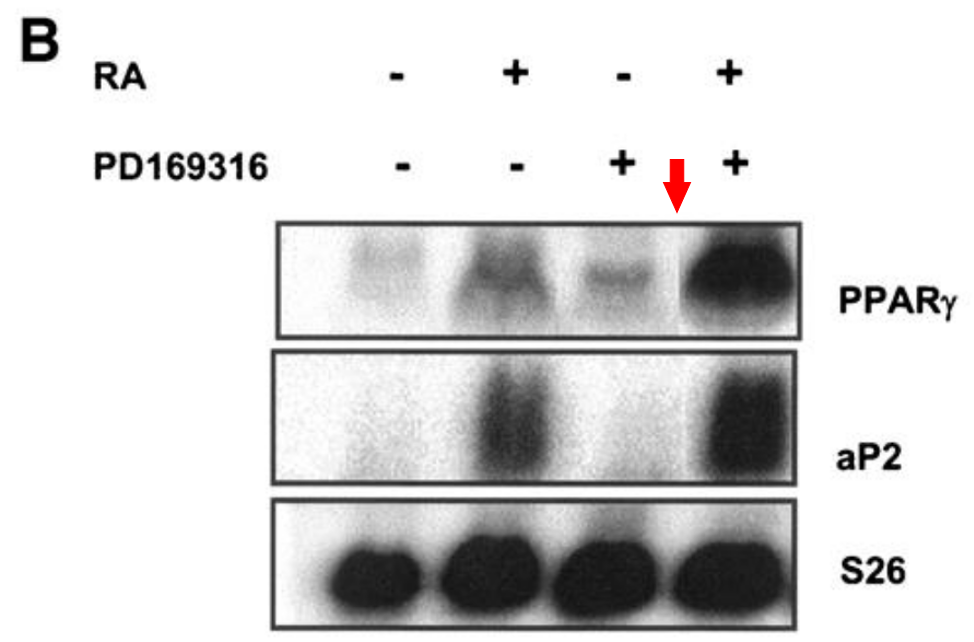
By the way, here a story about the Rector of the University of Nice and former Minister for Research, Frederique Vidal:
Frederique Vidal, Minister for Research and gel band duplication
Frédérique Vidal has been professor for molecular genetics and rector of the University of Nice before she became the currently serving cabinet Minister of Higher Education, Research and Innovation in France. The French government keeps responding with threats of legal action to earlier evidence of data irregularities in her published research, this is why I…
Update: an earlier version of this article contained a mistaken identity. Due to a shortage of extant online records, I erroneously confused Myriam Aouadi with a Novartis executive of the same name. Apologies for the mistake.
Scholarly Publishing
Judged this to be satisfactory
We are all used to publication ethics fails from MDPI and Elsevier, but The BMJ covering up bad science is a bit unexpected.
In November 2023, Clare Francis notified the BMJ-published journal Gut (impact factor 24.5) about problems in one old paper:
A Buda , D Qualtrough, M A Jepson , D Martines , C Paraskeva , M Pignatelli Butyrate downregulates alpha2beta1 integrin: a possible role in the induction of apoptosis in colorectal cancer cell lines Gut (2003) doi: 10.1136/gut.52.5.729
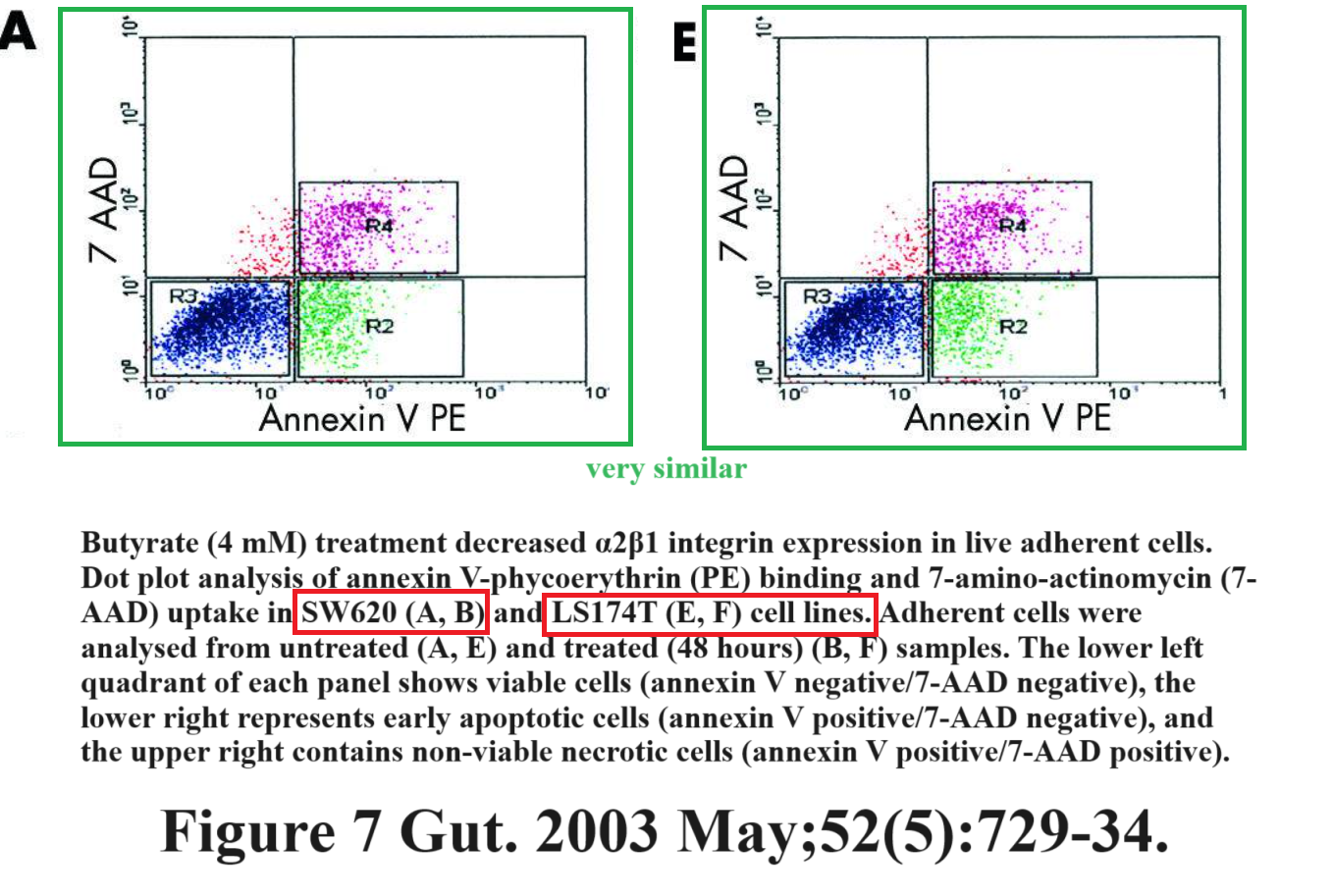
The paper had also a stealthily spliced gel. This what BMJ “Content Integrity” team wrote to Clare Francis on 19 March 2024, “On behalf of Dr Helen Macdonald and Ms Helen Hardy”
“Thank you for raising these concerns with BMJ regarding DOI 10.1136/gut.52.5.729. We are writing to update you on the status of these.
The Content Integrity team at BMJ contacted the article’s authors to request a response to the concerns raised. Details of the authors’ response can be found in the attachment. The Editor-in-Chief of the journal and the Content Integrity team reviewed the authors’ explanation, and judged this to be satisfactory. As such, we do not intend to pursue this matter further.
We have conveyed this decision to the authors, and we have encouraged them to post their rebuttal publicly on the PubPeer platform for the benefit of readers and in the interests of transparency.”
I didn’t receive the authors response, but I’m pretty sure it proves that conclusions were not affected. Now, about the authors.
The last author, an Italian native and former professor at the University of Glasgow in UK Massimo Pignatelli, has an established PubPeer record. In 2013, he moved to Kazakhstan to set up a medical school at the Nazarbayev University, where he became Dean and Vice President for Medicine. I am the last one to judge European scientists who bugger off to play big men in russia- and china-controlled corrupt authoritarian regimes. Christos Paraskeva is emeritus professor at the Bristol University in UK, and he also has an established PubPeer record. Both men used to collaborate with the Bristol mega-cheaters Paolo Maddeddu and Costanza Emanueli, read about them here:
Bristol Madness
“People should believe in themselves; to search the treasures that they have inside and use them to reinterpret the role.” – Paolo Madeddu,, Professor and Chair at University of Bristol.
Here is an example of Pignatelli-Paraskeva collaboration:
N Banu , A Buda , S Chell , D Elder , M Moorghen , C Paraskeva , D Qualtrough , M Pignatelli Inhibition of COX-2 with NS-398 decreases colon cancer cell motility through blocking epidermal growth factor receptor transactivation: possibilities for combination therapy Cell Proliferation (2007) doi: 10.1111/j.1365-2184.2007.00459.x
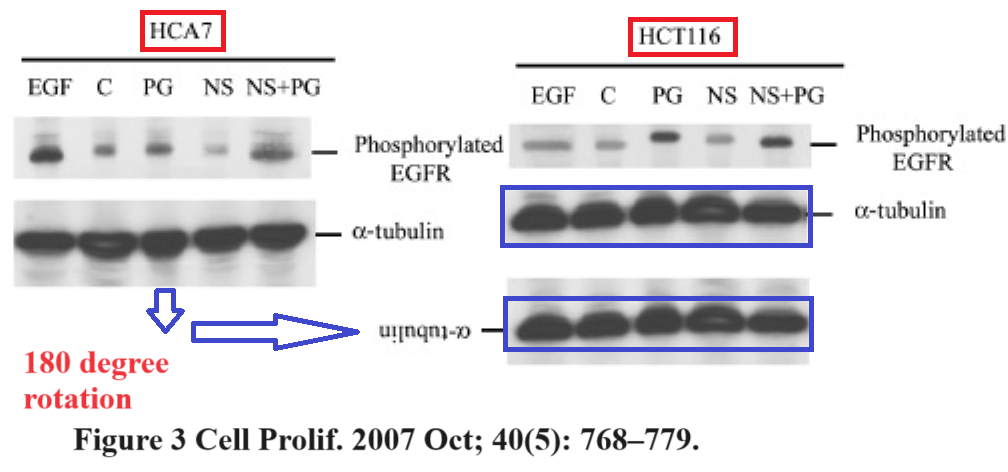
Pignatelli also used to collaborate with Nick Lemoine, Director of the Barts Cancer Institute at Queen Mary University of London. I wrote about Lemoine before, and be aware that an established record of fake science is mandatory for applications to senior academic positions at QMUL:
The English science supremacy
England leads the world in science, any fule kno. Meet some more of the star jesters: Nick Lemoine, Peter St George-Hyslop and Xin Lu. They are curing cancer and Alzheimer with Photoshop.
An ancient classic by Pignatelli, with gels lazily reused:
- A U Jawhari , M Noda , M J G Farthing , M Pignatelli Abnormal expression and function of the E-cadherin-catenin complex in gastric carcinoma cell lines British Journal of Cancer (1999) doi: 10.1038/sj.bjc.6690358
- Iman El-Hariry , Massimo Pignatelli , Nicholas R. Lemoine FGF-1 and FGF-2 regulate the expression of E-cadherin and catenins in pancreatic adenocarcinoma International Journal of Cancer (2001) doi: 10.1002/ijc.1515
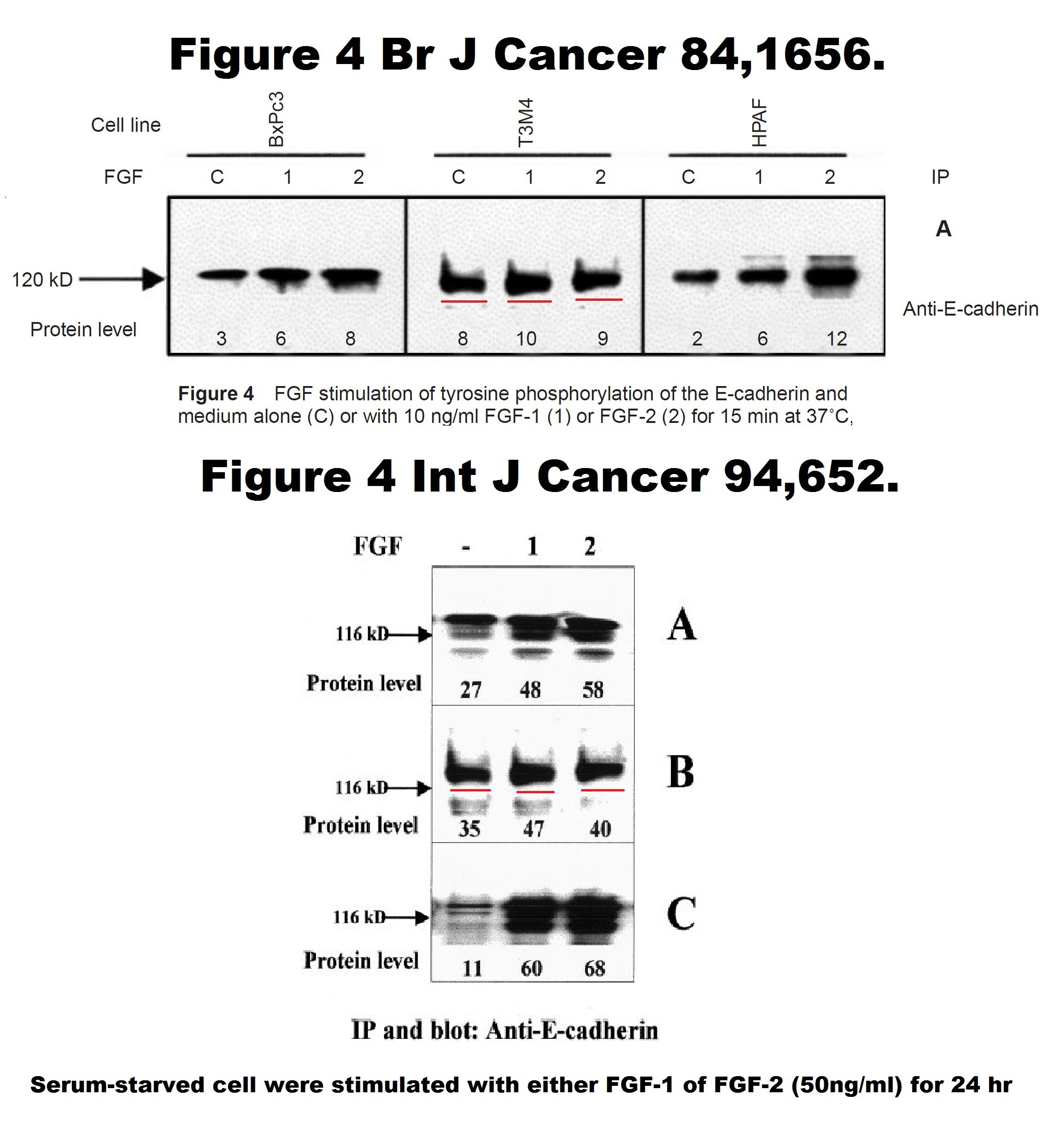
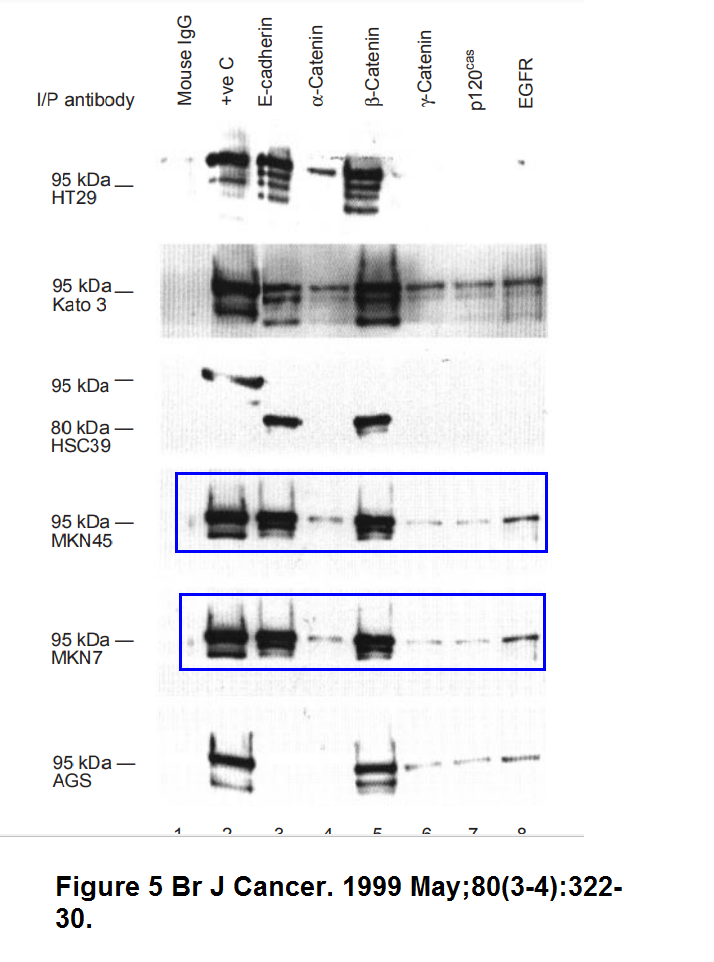
In February 2019, an Erratum was published for the 2001 paper:
“There is an error in the experimental conditions reported for the data presented in Figure 4 panel B. We apologize for these circumstances, which required clarification of the data.”
And here is Paraskeva, whose PubPeer record is even worse:
H J M Smartt , D J E Elder , D J Hicks , N A Williams , C Paraskeva Increased NF-kappaB DNA binding but not transcriptional activity during apoptosis induced by the COX-2-selective inhibitor NS-398 in colorectal carcinoma cells British Journal of Cancer (2003) doi: 10.1038/sj.bjc.6601266
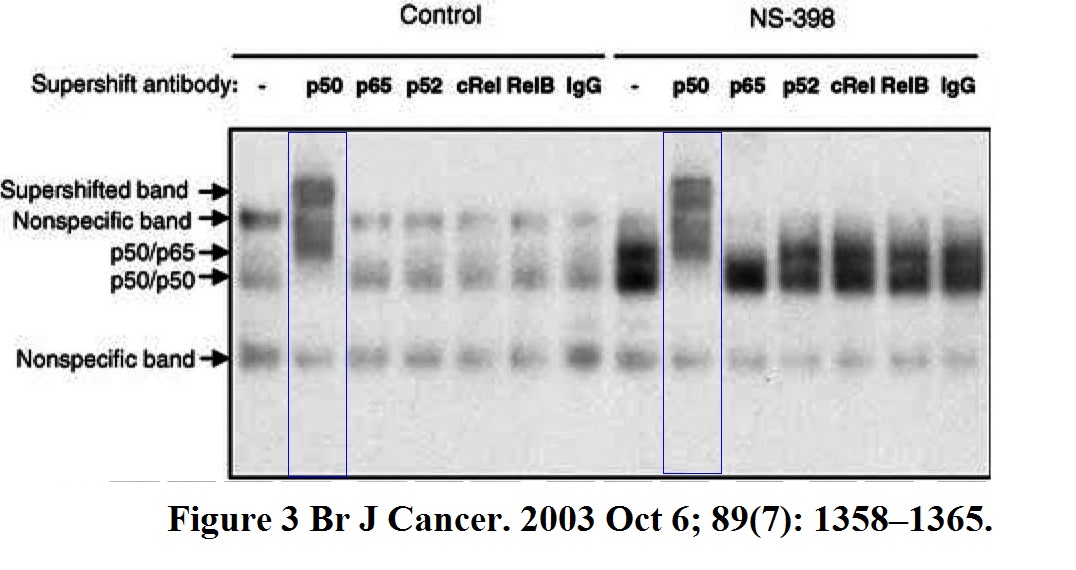
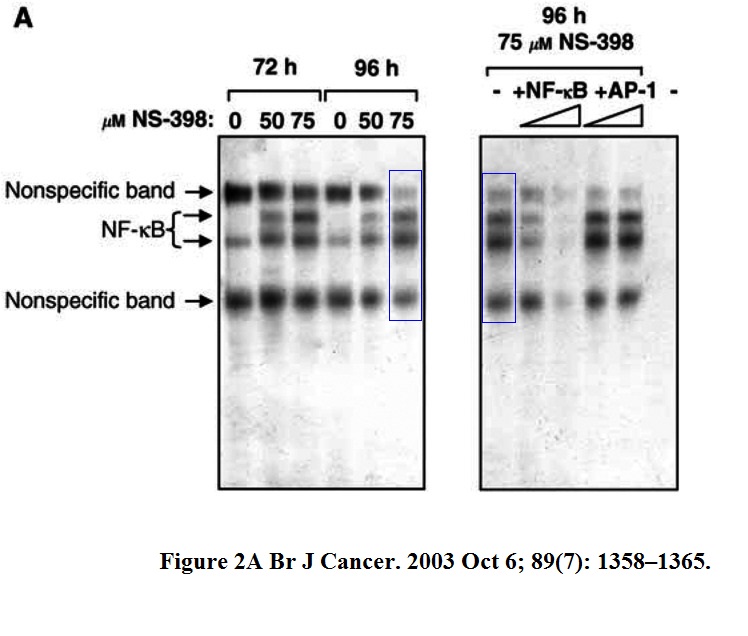
There is a whole string of fudged papers by Paraskeva jointly made with his former mentee Ann Williams, who spent almost her entire academic career in Bristol and became professor in 2013. For example:
J. D. Barnes , N. J. Arhel, S. S. Lee , A. Sharp , M. Al-Okail , G. Packham, A. Hague , C. Paraskeva , A. C. Williams Nuclear BAG-1 expression inhibits apoptosis in colorectal adenoma-derived epithelial cells APOPTOSIS (2005) doi: 10.1007/s10495-005-0804-8
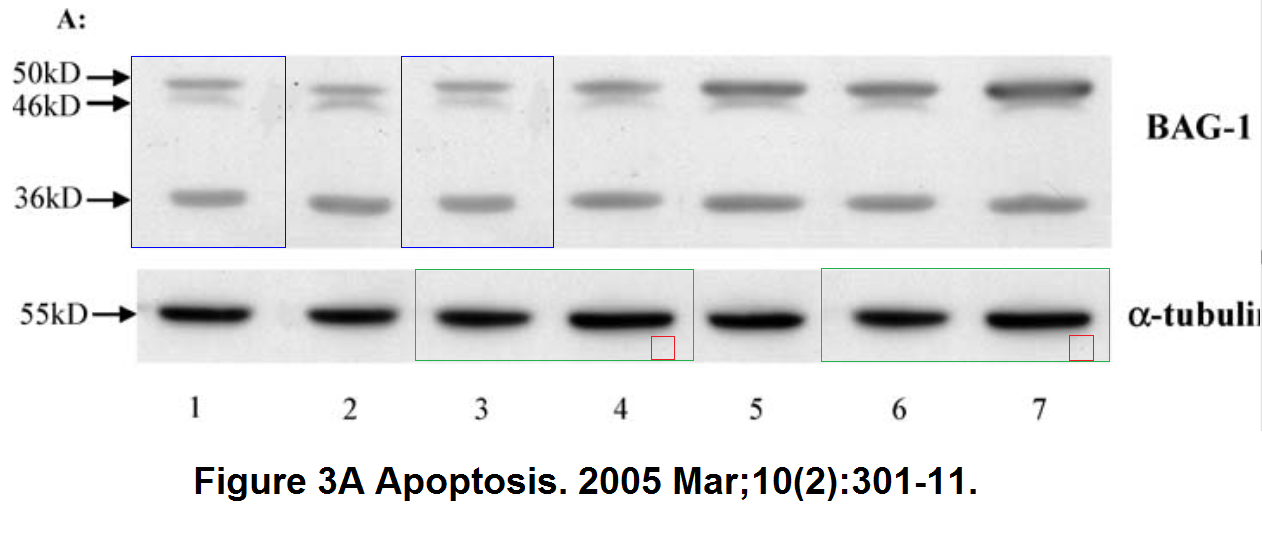

Another one:
Simon D. Chell , Ian R. Witherden , Richard R. Dobson , Morganaden Moorghen , Andrew A. Herman , David Qualtrough, Ann C. Williams, Christos Paraskeva Increased EP4 receptor expression in colorectal cancer progression promotes cell growth and anchorage independence Cancer Research (2006) doi: 10.1158/0008-5472.can-05-3702
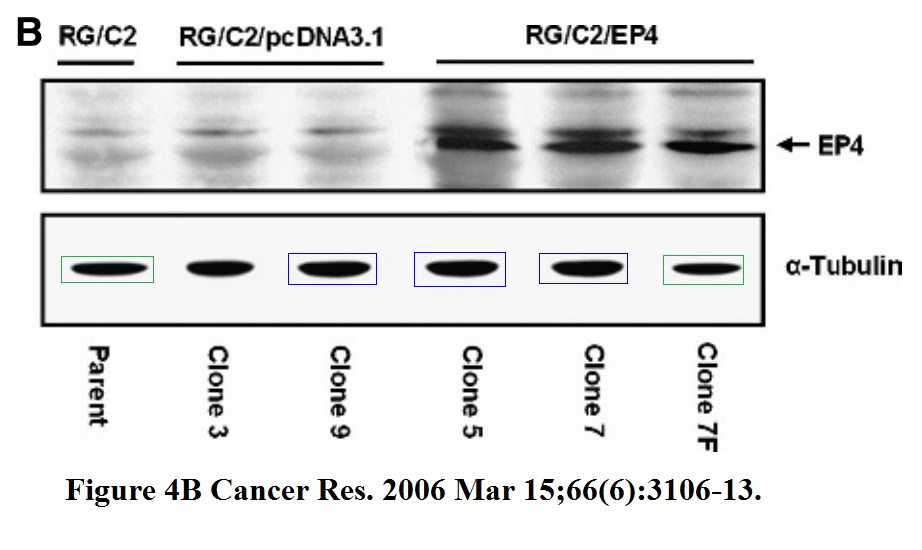
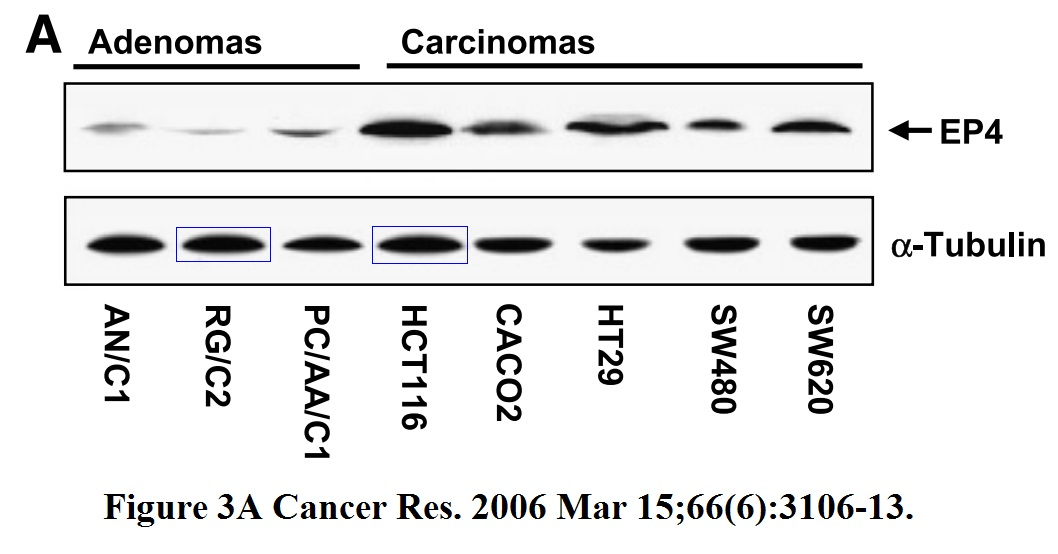
Here something else, instead of fake western blots:
Nathalie J. Arhel , Graham Packham , Paul A. Townsend , Tracey J. Collard, Akram M. H-Zadeh , Adam Sharp , Ramsey I. Cutress , Karim Malik , Angela Hague , Chris Paraskeva , Ann C. Williams The retinoblastoma protein interacts with Bag-1 in human colonic adenoma and carcinoma derived cell lines International Journal of Cancer (2003) doi: 10.1002/ijc.11257
“several other assays appear to be duplicated. Shown with enhanced sharpness. One set (marked with green) appears rotated. The brightness and contrast appears different in several cases“
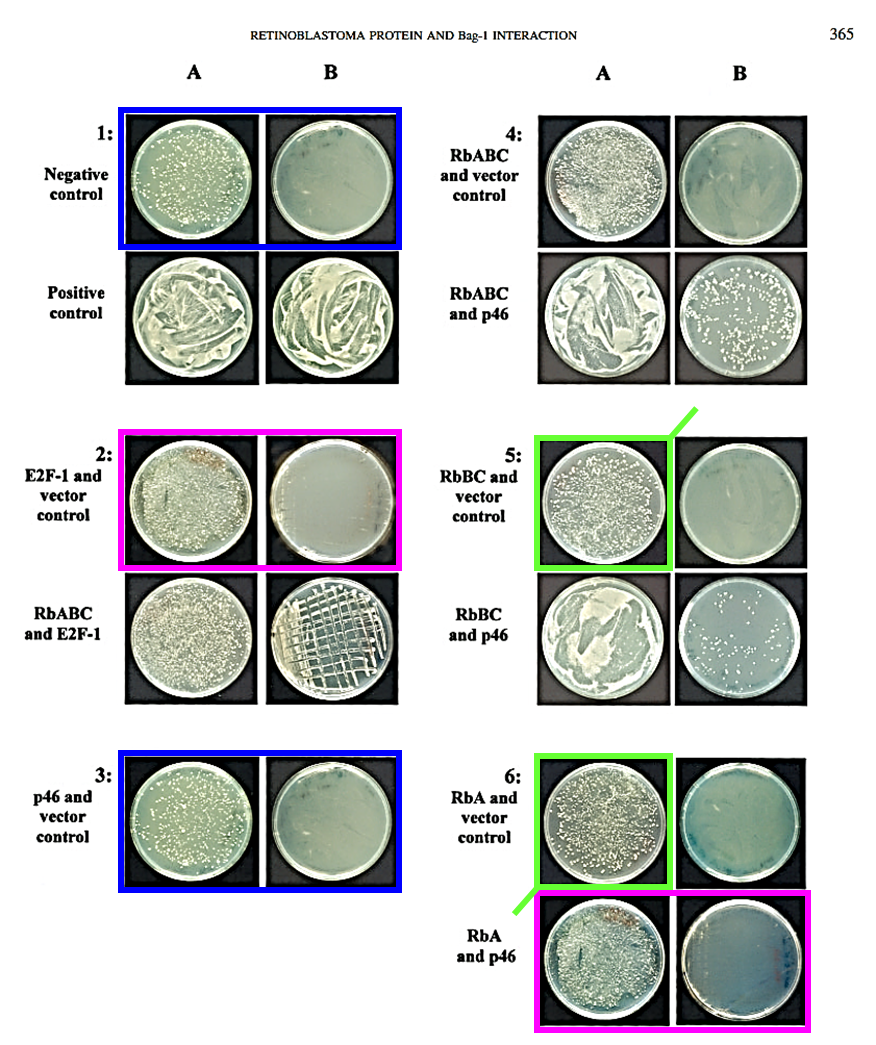
Luckily, in Bristol they don’t care much about research integrity, call it the Madeddu effect if you like. Last one by Williams and her mentor Paraskeva, the rest is on PubPeer:
A C Williams, H Smartt , A M H-Zadeh , M Macfarlane , C Paraskeva , T J Collard Insulin-like growth factor binding protein 3 (IGFBP-3) potentiates TRAIL-induced apoptosis of human colorectal carcinoma cells through inhibition of NF-kappaB Cell Death and Differentiation (2007) doi: 10.1038/sj.cdd.4401919 Fig 5c, duplciated gel bands
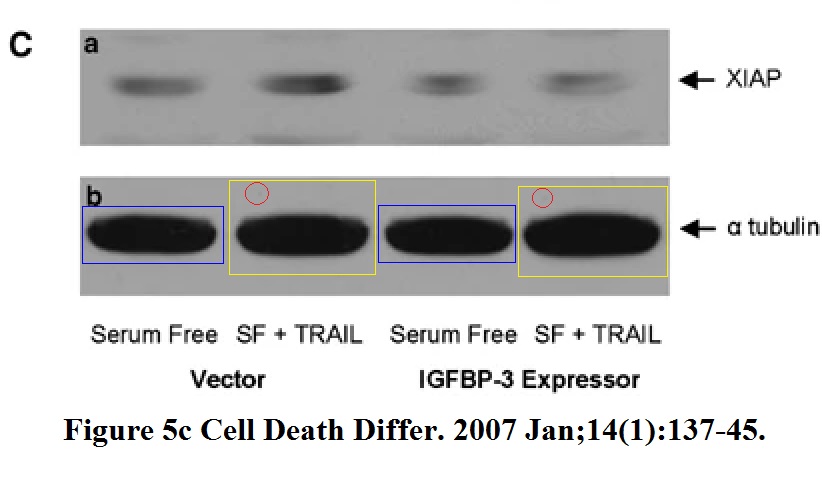
Williams protested on PubPeer in may 2022:
“We would never manipulate an image and given this is a loading control, it would be totally unnecessary.“
And now, BMJ agreed. People like Paraskeva and Pignatelli are 100% trustworthy.
An error in the compilation
Once again, EMBO press delivered a special service to an EMBO member. An unwritten rule is that EMBO members are protected from retractions in EMBO press journals, no matter what.
The luck one this time is the Great Dane Kristian Helin, EMBO member since 2002. This cancer researcher used to be professor in Copenhagen before taking the post of President of ICR London, which is a massive fraud factory.
Kristian Helin gets the perfect job
ICR London has a new director. The Great Dane Kristian Helin is the perfect successor to continue the ideological line of fictional cancer research.
And before all that, Helin was group leader at IFOM-IEO in Milan, Italy. This is where the now repaired paper was done:
Adrian P Bracken , Diego Pasini , Maria Capra , Elena Prosperini , Elena Colli , Kristian Helin EZH2 is downstream of the pRB-E2F pathway, essential for proliferation and amplified in cancer The EMBO Journal (2003) doi: 10.1093/emboj/cdg542

On 12 February 2024, EMBO Press issued this Correction:
“SUZ12 blot in the context of mutant E2F1(E132) in Figure 1B, is retracted.
A similarity between the first two lanes in the SUZ12 E2F1(E132) blot in Figure 1B was detected. In the absence of source data, the SUZ12 E2F1(E132) blot is retracted. The conclusions of the article are not affected.
Author statement:
We (the authors) believe there was an error in the compilation of the SUZ12 blot of mutant E2F1(E132). The original scans of the Northern blots were not retained. However, this does not affect the conclusions of the paper as this was a negative control (E2F1 mutant) of a control (SUZ12), since this paper was focused mostly on EZH2. In fact, the 5 other SUZ12 panels in Figure 1 confirm that SUZ12 is an E2F regulated gene, as was also previously reported also by four prior papers (References Müller et al (2001), Weinmann et al (2001), Kirmizis et al (2003), Vernell et al (2003)).
All Authors agree with the above statement.”
Obviously, negative controls are supposed to be fake, if they are not – you are a failed scientist. Also, two of these 4 references are by Helin himself. He just earned himself extra citations!
Two EMBO corrections for the martyred saint Maria Pia Cosma
The martyrdom of St Maria Pia.
Correction seems like the right approach
On 29 December 2023, the pseudonymous sleuth Dayo Maor wrote to the editor of Chemistry – A European Journal, issued by European Chemical Societies Publishing and Wiley. It was about three papers, “by the same group and first author“, with “NMR spectra clearly fabricated by copy-paste as evidenced by repetitive fragments of noise“. The sleuth also reminded the editors that “several papers in other journals are reported” on PubPeer for the last author Hermenegildo Garcia, professor at the Technical University of Valencia and a Highly Cited Researcher.

Those were the three papers explaining Garcia’s success, his lab alumnus Roberto Martin is lead author on all problematic papers, and is now described on Garcia’s website as “Associate Researcher, University of Salamanca”. Dayo Maor also shared the evidence on X, in November 2023.
Roberto Martín , Liliana Jiménez , Mercedes Alvaro , Juan C. Scaiano , Hermenegildo Garcia Two‐Photon Chemistry in Ruthenium 2,2′‐Bipyridyl‐Functionalized Single‐Wall Carbon Nanotubes Chemistry – A European Journal (2010) doi: 10.1002/chem.200903506
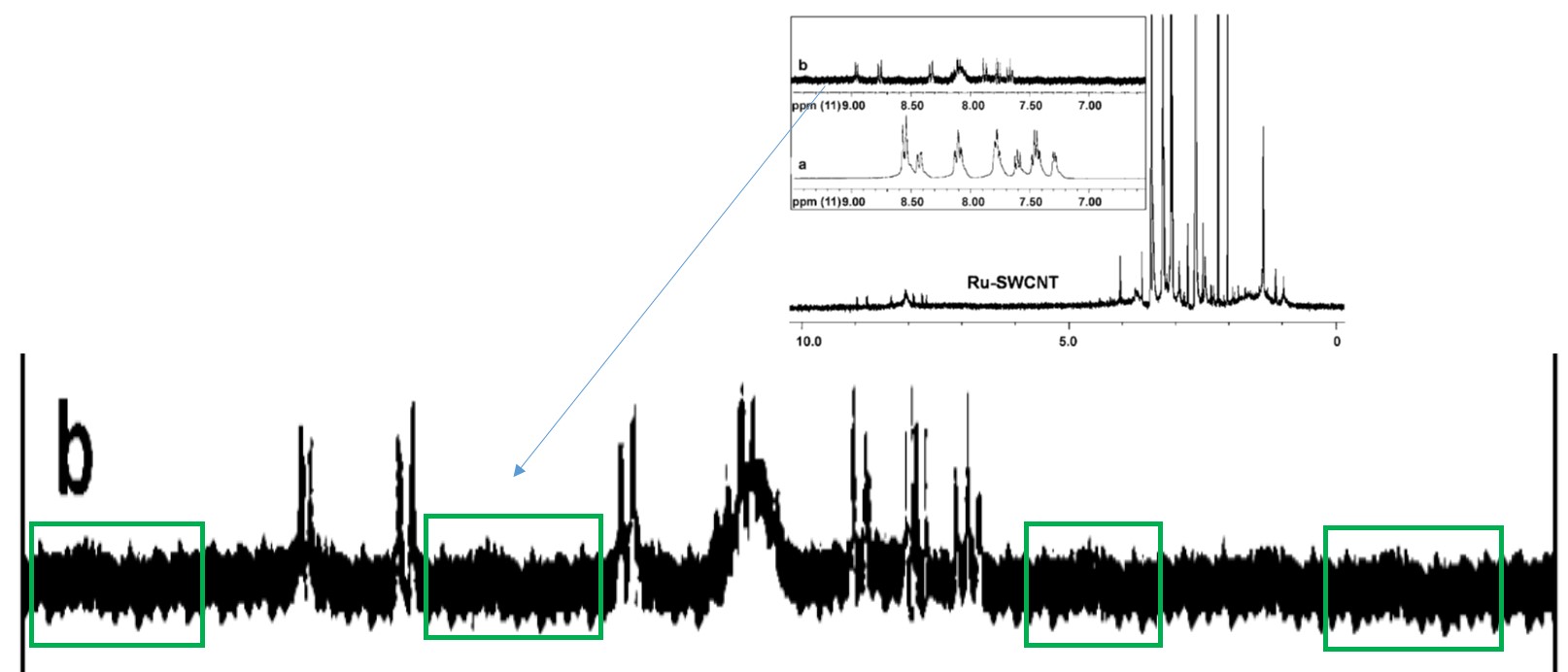
Carmela Aprile , Roberto Martín , Mercedes Alvaro , Juan C. Scaiano , Hermenegildo Garcia Functional Macromolecules from Single‐Walled Carbon Nanotubes: Synthesis and Photophysical Properties of Short Single‐Walled Carbon Nanotubes Functionalised with 9,10‐Diphenylanthracene Chemistry – A European Journal (2008) doi: 10.1002/chem.200800186
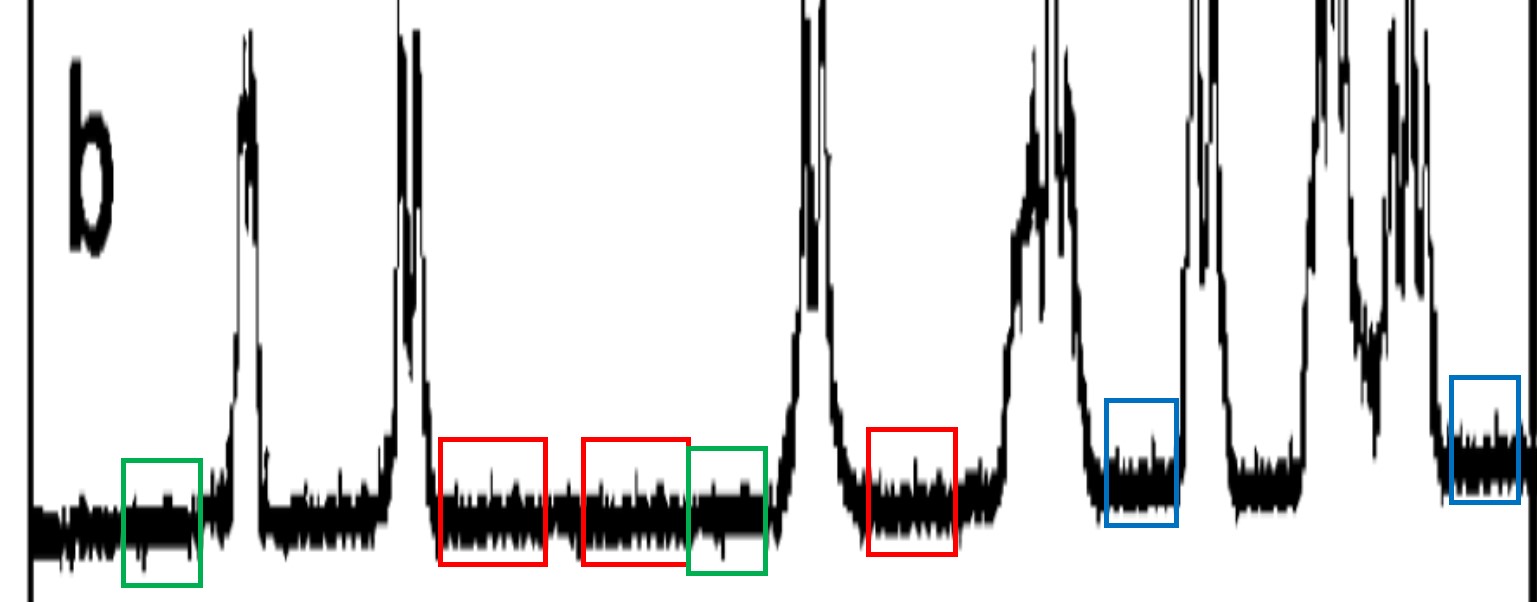
Carmela Aprile , Roberto Martín , Mercedes Alvaro , Juan C. Scaiano , Hermenegildo Garcia Functional Macromolecules from Single‐Walled Carbon Nanotubes: Synthesis and Photophysical Properties of Short Single‐Walled Carbon Nanotubes Functionalised with 9,10‐Diphenylanthracene Chemistry – A European Journal (2008) doi: 10.1002/chem.200800186

Two other two papers by Martin and Garcia in the journal Chemistry of Materials have same kind of badly fake spectra, with repetitive noise patterns – Aprile et al 2009 and Martin et al 2009, the latter was additionally criticised to be scientifically nonsense.
On 2 January 2024, Haymo Ross, a Wiley employee and Editor-in Chief of Chemistry – A European Journal , replied to the sleuth:
“Dear Dayo Maor,
Thanks for drawing this matter to our attention. Rest assured that we will investigate these papers. Whether they will have to be retracted can only be decided after the investigation. Note that posting such a discovery on social media prior to contacting the editorial office does not necessarily help in the investigation.
Would you mind sharing more detailed contact information?“
On 14 March 2024, Ross completed his investigation, and wrote to the sleuth again:
“Dear Dayo,
The authors reran the spectra and provided us with a corrected spectra. They proposed to correct the altered NMR spectra by new ones that have been recorded in February/March 2024 with new samples synthesized specifically to clarify the problem. Given that these new spectra are quite similar to the altered ones and, importantly, confirm the claims of these articles, the solution the authors propose is to correct those figures and maintain the conclusions of those papers. Our integrity assurance and case resolution team has approved this proposal and acknowledges a correction seems like the right approach, following best practice. In addition, the authors will be asked to apologize for the manipulation in the correction text.”
To sum up Wiley’s ethics: the authors admitted their data was fake, but it is OK because they agreed to replace their fake data with another fake set, and the only one guilty of misconduct is the sleuth Dayo Maor, who posted things on social media.
This will be processed and published
In an Elsevier journal overrun by papermills, the Editor-in-Chief decided to go for corrections also. It is the journal Fuel, whose co-EiC Jillian Goldfarb was pushed out because she protested too much against papermilling fraud going on in her journal, including on the chief editor level. Her colleague Bill Nimmo, professor at the University of Sheffield in UK, took over. Read here:
Elsevier chooses Papermills and Patriarchy, Chief Editor resigns
“Among these candidates that you “vetted” were people with no expertise in the field (either 0 or 1 publication), people with longer PubPeer profiles and more retractions than most people have articles on their CVs, and people whose names appear as authors on sold paper sites. ” – Jillian Goldfarb
Now, three papers by the notorious papermilling gang of Pau Loke Show, Awais Bokhari and Muhammad Mubashir which were reported to Nimmo on 7 March 2024:
- Sumera Arshad , Mushtaq Ahmad , Mamoona Munir , Shazia Sultana , Muhammad Zafar , Sumreen Dawood , Rozina , Ahmad M. Alghamdi , Saira Asif , Awais Bokhari , Muhammad Mubashir, Lai Fatt Chuah, Pau Loke Show Assessing the potential of green CdO2 nano-catalyst for the synthesis of biodiesel using non-edible seed oil of Malabar Ebony Fuel (2023) doi: 10.1016/j.fuel.2022.126492
- Rozina , Mushtaq Ahmad , Saira Asif , Jiří Jaromír Klemeš , Muhammad Mubashir , Awais Bokhari , Shazia Sultana , Ahmad Mukhtar , Muhammad Zafar , Aqeel Ahmed Bazmi , Sami Ullah , Mohd Shariq Khan , Apurav Krishna Koyande , M. Mofijur , Pau-Loke Show Conversion of the toxic and hazardous Zanthoxylum armatum seed oil into methyl ester using green and recyclable silver oxide nanoparticles Fuel (2022) doi: 10.1016/j.fuel.2021.122296
- Rozina , Shir Reen Chia , Mushtaq Ahmad, Shazia Sultana , Muhammad Zafar , Saira Asif , Awais Bokhari , Saifuddin Nomanbhay , Muhammad Mubashir, Kuan Shiong Khoo, Pau Loke Show Green synthesis of biodiesel from Citrus medica seed oil using green nanoparticles of copper oxide Fuel (2022) doi: 10.1016/j.fuel.2022.124285
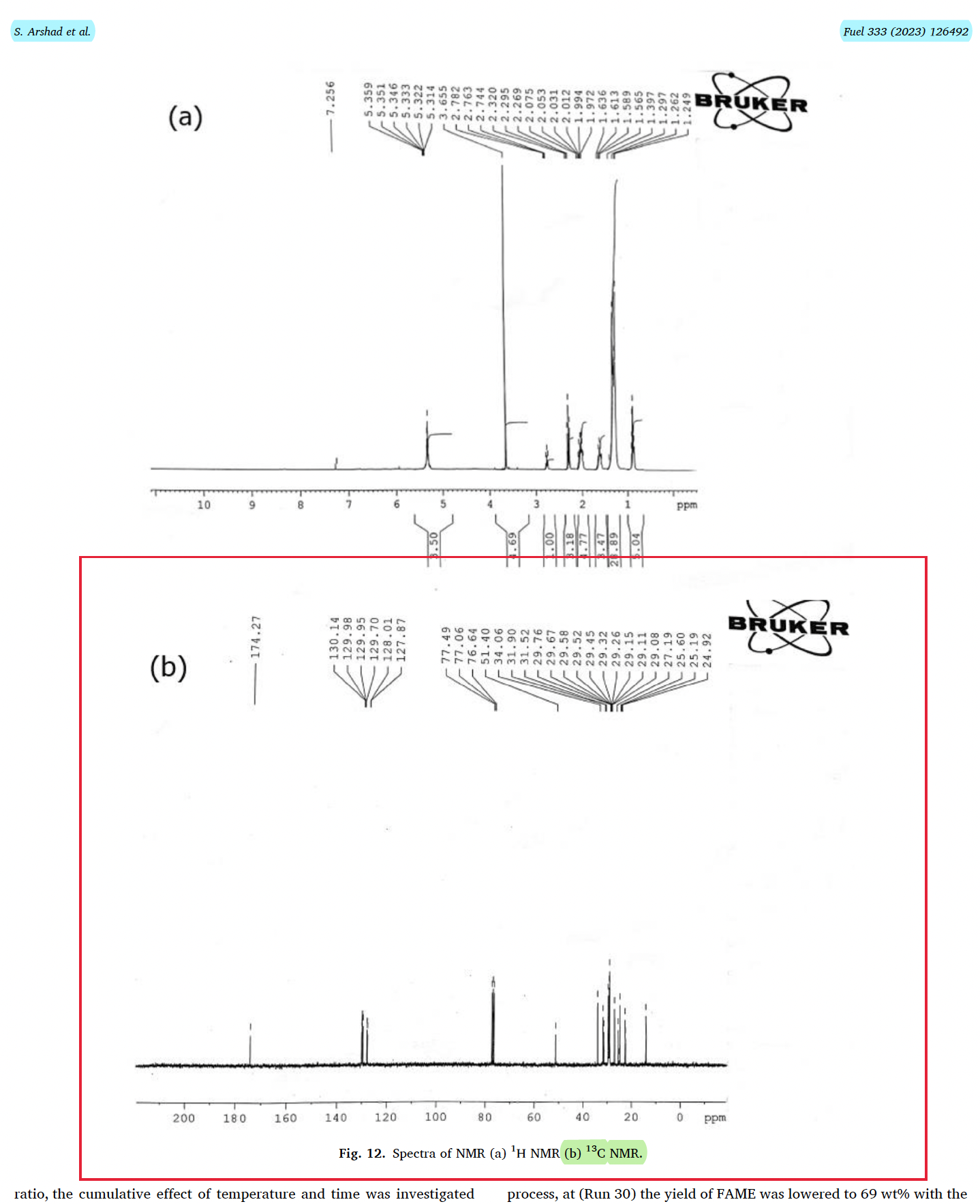
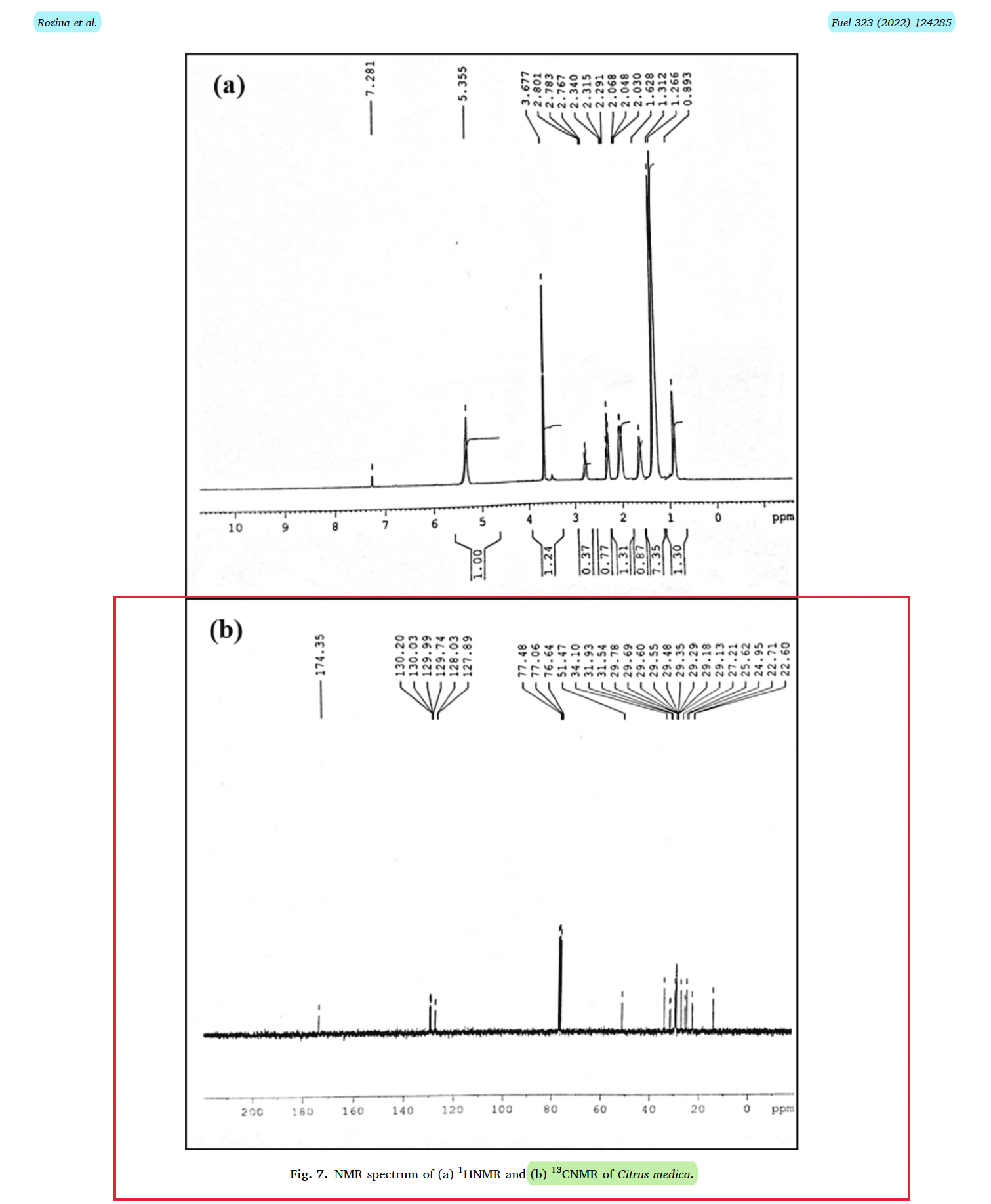
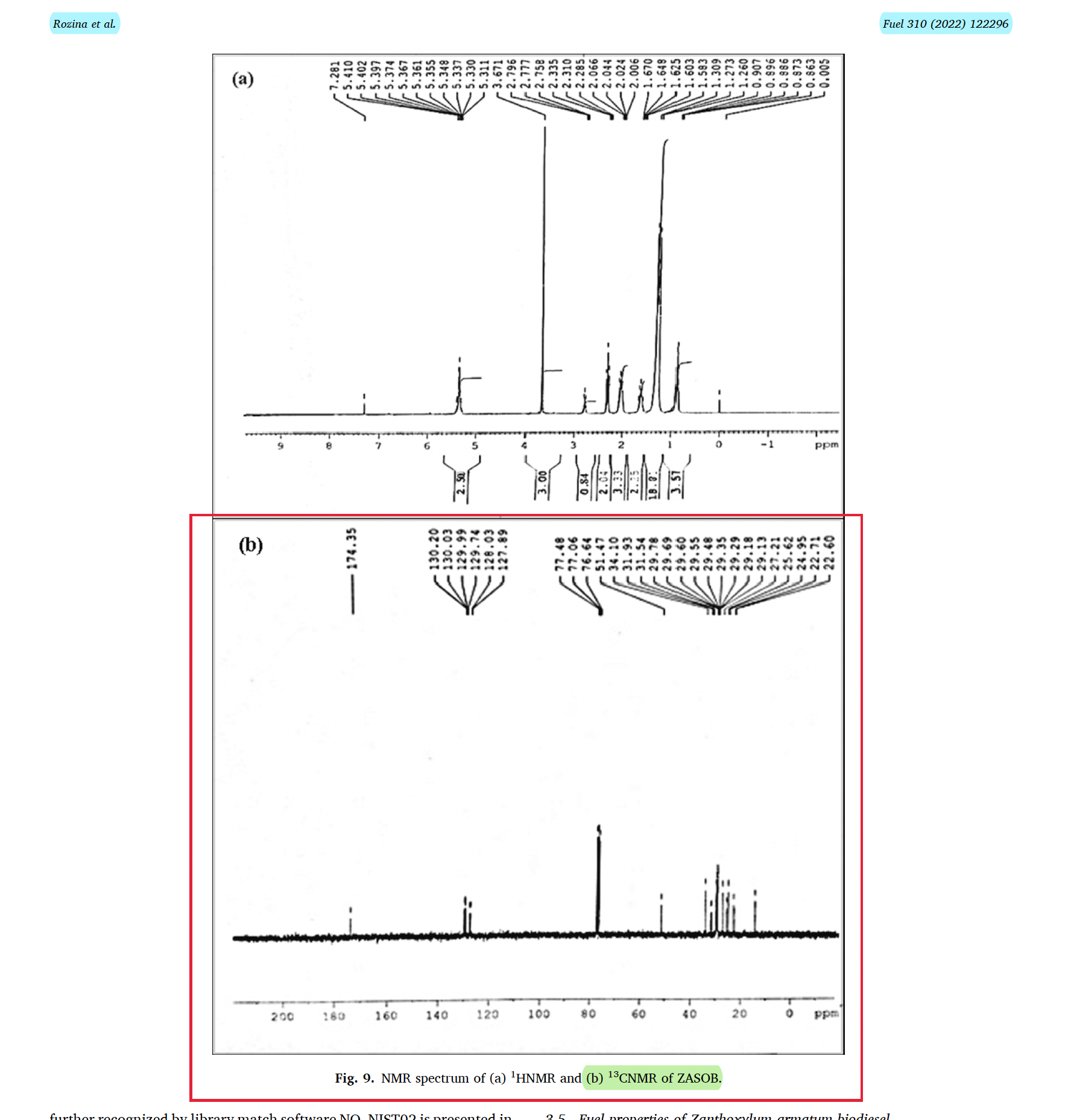
Conversion of the toxic and hazardous Zanthoxylum armatum seed oil into methyl ester using green and recyclable silver oxide nanoparticles”
left, Rozina et al 2022b: “Fig. 7b: Green synthesis of biodiesel from Citrus medica seed oil using green nanoparticles of copper oxide”
Worth mentioning that one coauthor, the Czech professor and Highly Cited Researcher Jiří Jaromír Klemeš, died in January 2023, but he continues papermilling from his grave. Seriously. His bereaved papermilling colleagues Show, Mubashir and Bokhari, plus some others, featured in this article:
Hier kommt Herr Sonne
“Go and change the globe to a more positive future instead”
Nimmo replied right away:
“Have you contacted the editors [Nimmo later corrected himself to “the authors”, -LS]
I mention this because we would normally be contacted after an initial discussion has taken place. Potentially by the author requesting a correction.“
On 11 March Nimmo announced to have “contacted the editors”, he must have meant the authors again. On 13 March 2024, he announced his decision:
“The corresponding author has responded and offered a full corrigendum to explain and correct the issues that you highlighted in your correspondence.
This will be processed and published.
I hope this will resolve the issue.“
So we all hope, Bill, you papermill-enabling nincompoop. But this is exactly the kind of stewardship Elsevier expects from its chief editors.
Industry Giants
The textbook definition of snake oil salesman
Anti-aging scammer and Harvard Professor David Sinclair has opened yet another business. His anti-aging scamming peers are furious, afraid that Sinclair will scam away all the money for himself and won’t leave them enough market share.
Never-ageing Anti-aging to cure COVID-19
Scientists David Sinclair and Michael Lisanti have an ingenious solution to COVID-19: anti-aging drugs. If a disease kills old people, stop being old!
That follows Sinclair’s legendary scoop from 2008 of selling the company Sirtis to the pharma giant GlaxoSmithKline (GSK) for $700 million. Sirtis was founded by Sinclair and his former mentor, the MIT professor Leonard Guarente to market the magic substance resveratrol as anti-aging supplement. GSK soon regretted the purchase and in 2010 abandoned the SIRT research.
After that, Sinclair and Guarente founded the anti-aging company Elysium Health, which sells NAD+ supplements patented by Sinclair. It has EIGHT Nobel Prize laureates on board, plus another MIT professor, George Church. It is however very difficult to market anti-aging crap to humans, what with FDA approvals and lack of efficacy.
The original sins of Leonard Guarente
“Without specific and credible allegations of research misconduct, MIT is unable to take any action.”
But then someone in the anti-aging community had the idea: dogs! Huge market, no regulation at all. Dogs live 15 years or so, even if they die early, one can always bullshit the owner that the magic therapy gave their beloved pet a few extra months or even years. And everyone went barking mad at the prospects of money to be made.
As I wrote in earlier Friday Shorts from January 2023, at the University of Washington professor Matt Kaeberlein and owner of the anti-aging business Optispan Ventures (which also runs a longetivity clinic) started to feed rapamycin to the dogs and to himself. Church founded the company Rejuvenate Bio, focussed on rejuvenating dogs with FGF21, soluble TGFb receptor, and Klotho proteins – seemingly Sinclair was involved.
George Church, Colossal W*nker
From mammoths to eugenics to anti-aging scams: god-impersonator George Church knows how to make money with bullshit.
And Sinclair, together with his brother Nick Sinclair, now opened a business called Animal Biosciences Inc. They issued a press release on 5 March 2024:
“Animal Biosciences, Inc., a company aiming to extend the lifespan of pets, today announced new clinical research published to the preprint server BioRxiv that tested the effects of their “LeapYears” supplement designed to extend healthspan in dogs.
After five years of development and testing in dogs, leveraging discoveries made at Harvard Medical School, the study shows the first clinical evidence that it is possible to reverse age-related decline in dogs.
The supplement, formulated as a soft chew, is a combination of an “NAD booster” to mimic fasting, and a molecule that kills “zombie” senescent cells that cause aging. The combination was developed because the effects in vivo were better than the single molecules alone. […]
Dr. David A. Sinclair, AO, PhD, Professor of Genetics at Harvard Medical School and co-founder of Animal Biosciences, stated, “I am very proud of the teams at NCSU and Animal Biosciences, who, after years of collaborative research and a clinical trial, have developed the first supplement shown to reverse the effects of age related decline in dogs.””
This is the preprint, done in collaboration with North Carolina State University professor Natasha Olby (“The authors have declared no competing interest“):
Katherine E. Simon, Katharine Russell, Alejandra Mondino, Chin-Chieh Yang, Beth C Case, Zachary Anderson, Christine Whitley, Emily Griffith, Margaret E. Gruen, Natasha J. Olby A Randomized, Controlled Clinical Trial Demonstrates Improved Cognitive Function in Senior Dogs Supplemented with a Senolytic and NAD+ Precursor Combination bioRxiv (2024) doi: 10.1101/2024.02.26.581616
It create a huge furore, and it seems many anti-aging scammers envy Sinclair his shameless insolence. A war broke out – Kaeberlein against Sinclair on X:
“After careful consideration, I have renounced my membership in the Academy for Health and Lifespan Research (@ahlresearch). I find it deeply distressing that we’ve gotten to a point where dishonesty in science is normalized to an extent that nobody is shocked when a tenured @Harvard professor falsely proclaims in a press release that a product he is selling to pet owners has “reversed aging in dogs”. To me, this is the textbook definition of snake oil salesman. […]
I have renounced my membership in the Academy due to ongoing behavior by Academy President Dr. David Sinclair that I find both personally and professionally unacceptable.”
Elswhere in the anti-aging kitchen, pots started to call kettles black.
On 13 March 2024, Sinclair suddenly resigned as President of the Academy for Health & Lifespan Research, as its founder Nir Barzilai announced on X, also on behalf of his colleagues Eric Verdin, Laura Neiderhofer and Andre Bertram. Sinclair has been just elected into this job. A press release was issued by the academy two days later.
Science Breakthroughs
Try to maximize my longevity
With absolutely no connection whatsoever to the Sinclair anti-aging scandal, his rapamycin-pushing competitors managed to place an article in the Washington Post extolling rapamycin as a miracle drug against anti-aging. For extra context: research around the mTOR protein (mammalian target of rapamycin) is heavily mired in fraud:
mTOR: conclusions not affected?
David Sabatini, remember that story? Well, it seems the conclusions were not affected. I take an ill-informed look at the mTOR signalling research field, to understand how photoshopped data gets to be independently verified by other labs.
From the WaPo article from 15 March 2024:
“Rapamycin was collected by a scientific expedition in the 1960s from the soil of Easter Island, also known as Rapa Nui, one of the most remote inhabited places on earth. The FDA approved it in 1999 to help transplant patients tolerate their new organs. But scientists kept exploring how the drug worked and ultimately set the field of longevity medicine abuzz.”
A longetivity researcher is quoted:
““I would say that rapamycin is the current best-in-class for a longevity drug that we have,” said Matt Kaeberlein, a professor the University of Washington who has researched rapamycin for two decades and is studying its anti-aging effects in dogs. In his own experience, he credited rapamycin’s anti-inflammatory properties with healing his persistent shoulder pain.”
Not in the WaPo article: Kaeberlein owns a longetivity clinic which pushes off-label rapamycin. His company Optispan now started a clinical trial for rapamycin as tooth paste ingredient.

The story features other rapamycin salesmen and their wealthy high-profile customers. And:
“Eric Verdin, chief executive of the Buck Institute on Aging, says there’s a strong case to be made for rapamycin as an anti-aging drug but hastens to add: “We should not as a field recommend use on people.” He and many other doctors say rapamycin is no substitute for exercise and a healthy diet.
“People going on it, using it as a substitute for a healthy lifestyle, it’s a bridge too far for me,” Verdin said. Then he offered a disclosure: He takes rapamycin.
“I’m doing everything I can to try to maximize my longevity,” said Verdin, who is 66.”
Eric Verdin is a Belgian native, he arrived to USA after graduating with PhD at the fraud-infested University of Liege.
My Liège is not so vile a sin
“The Board of Ethics and Scientific Integrity of University of Liège investigated the overlap between the aforementioned panels and recommended the article be corrected”
But we shan’t accuse people by association. Verdin’s own rapamycin/mTOR research speaks for itself. Volumes, even. Currently around a dozen of papers on PubPeer. For example, here is Verdin with a hero of above article, Liege professor and yet another anti-aging entrepreneur, Vincenzo Castronovo:
Nidhi Ahuja , Bjoern Schwer , Stefania Carobbio , David Waltregny , Brian J. North , Vincenzo Castronovo , Pierre Maechler , Eric Verdin Regulation of insulin secretion by SIRT4, a mitochondrial ADP-ribosyltransferase Journal of Biological Chemistry (2007) doi: 10.1074/jbc.m705488200 Fig 3, duplicated gel band
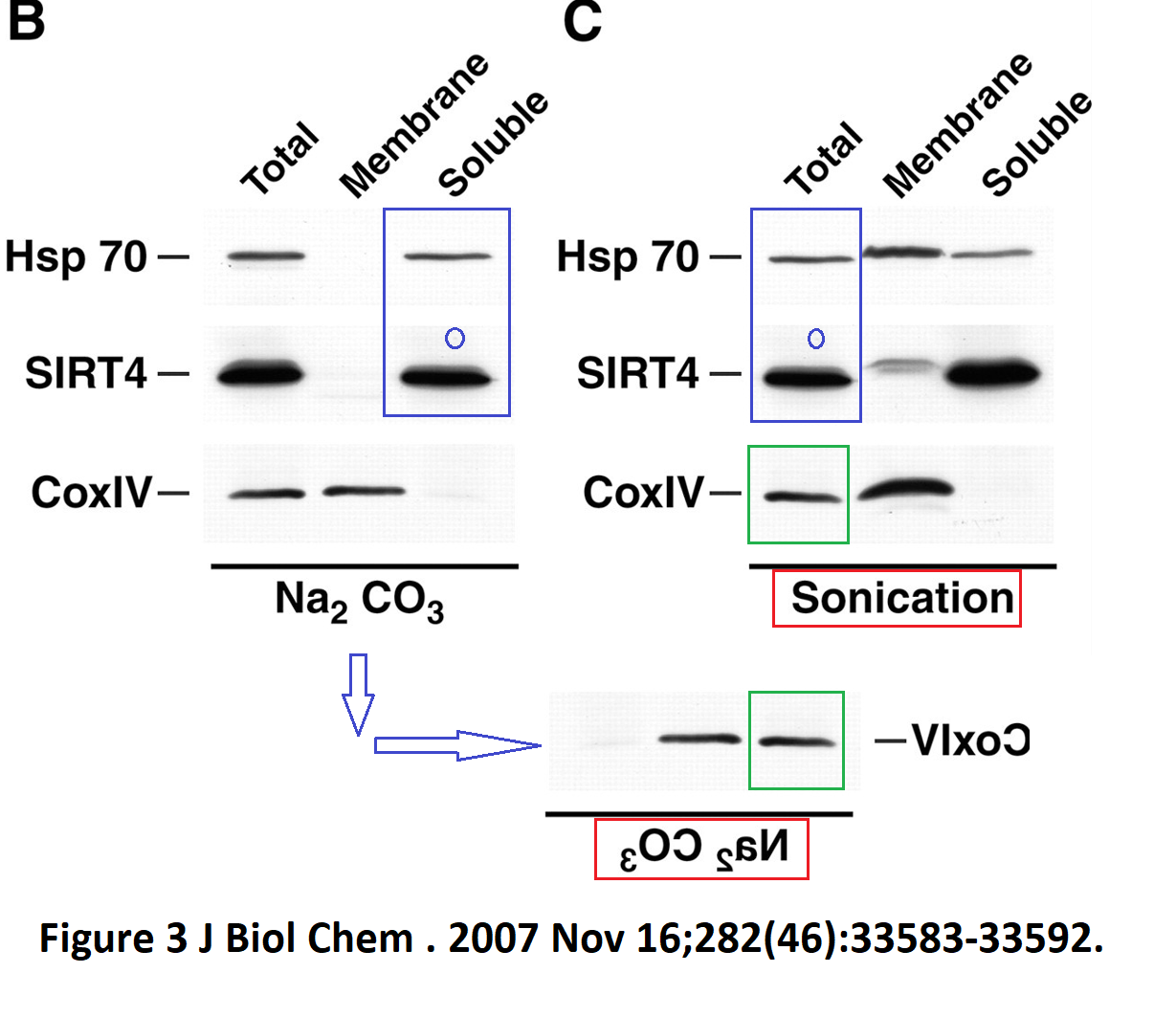
Verdin holds patents on SIRT-related therapies, but he doesn’t like to disclose them in his papers (see Lim et al 2015). Sometimes Verdin agrees to correct his papers (Rafati et al 2011), mostly he doesn’t.
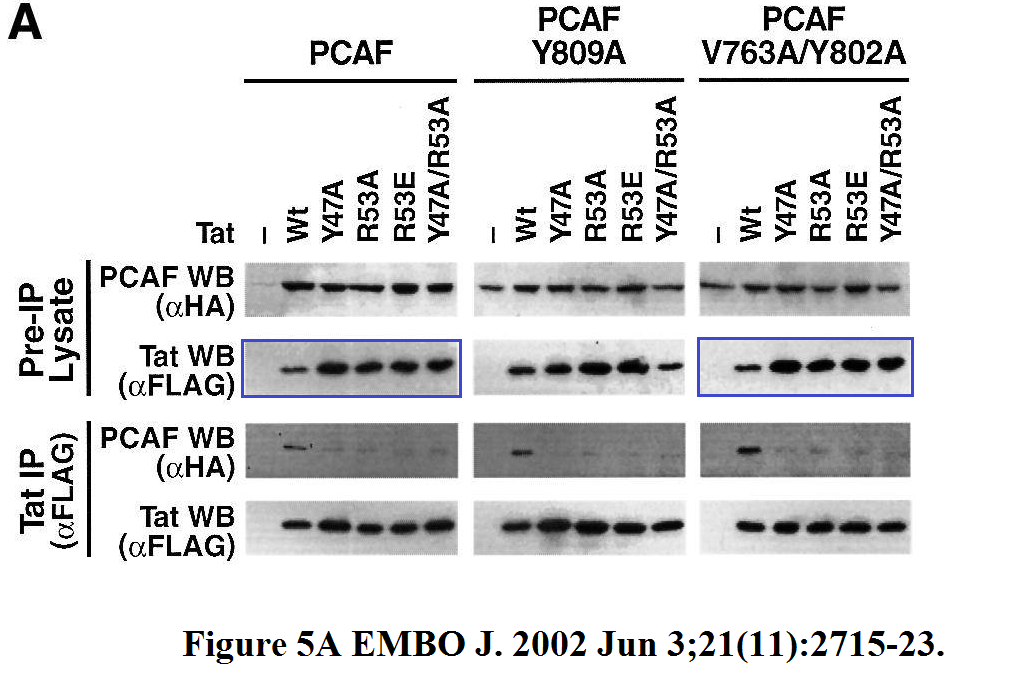
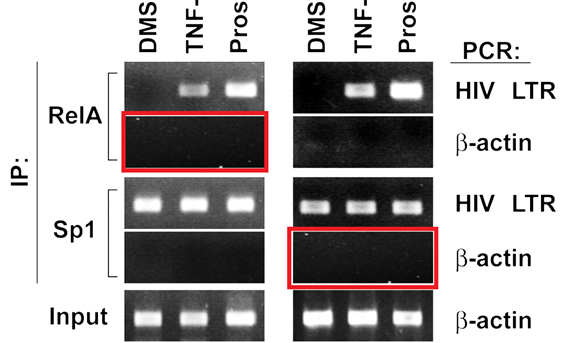
And here is Verdin with the very questionable Harvard professor C Ronald Kahn, defying Nature guidelines with some stealthily spliced gels:
Matthew D. Hirschey , Tadahiro Shimazu , Eric Goetzman , Enxuan Jing , Bjoern Schwer , David B. Lombard , Carrie A. Grueter , Charles Harris , Sudha Biddinger , Olga R. Ilkayeva , Robert D. Stevens , Yu Li , Asish K. Saha , Neil B. Ruderman , James R. Bain , Christopher B. Newgard , Robert V. Farese Jr , Frederick W. Alt, C. Ronald Kahn, Eric Verdin SIRT3 regulates mitochondrial fatty-acid oxidation by reversible enzyme deacetylation Nature (2010) doi: 10.1038/nature08778
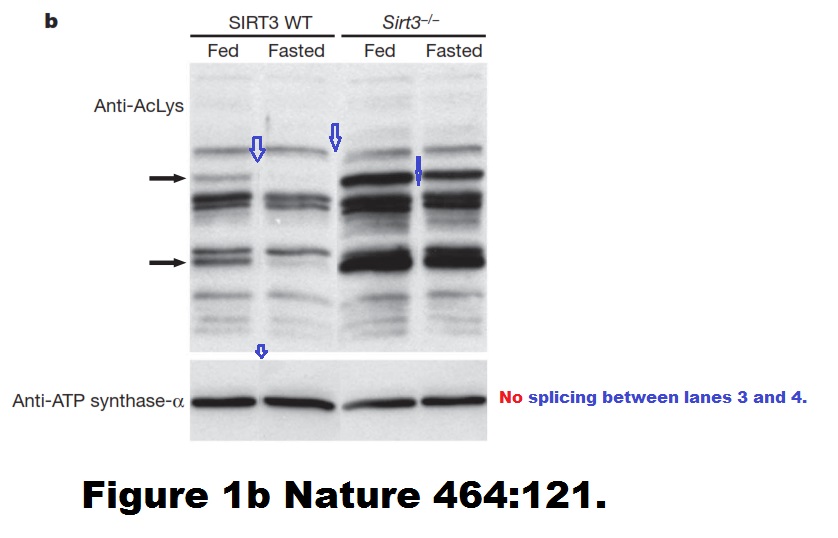

C Ronald Kahn and The Problem of Irreproducible Bioscience Research
“not everyone in the research community accepts that the problem requires such attention; some believe it is overblown.” -Jeffrey Flier, emeritus dean of Harvard Medical School
Another one by these two great men of science:
Matthew D. Hirschey , Tadahiro Shimazu , Enxuan Jing , Carrie A. Grueter , Amy M. Collins , Bradley Aouizerat , Alena Stančáková , Eric Goetzman , Maggie M. Lam , Bjoern Schwer , Robert D. Stevens , Michael J. Muehlbauer , Sanjay Kakar , Nathan M. Bass , Johanna Kuusisto , Markku Laakso , Frederick W. Alt , Christopher B. Newgard , Robert V. Farese , C. Ronald Kahn, Eric Verdin SIRT3 deficiency and mitochondrial protein hyperacetylation accelerate the development of the metabolic syndrome Molecular Cell (2011) doi: 10.1016/j.molcel.2011.07.019
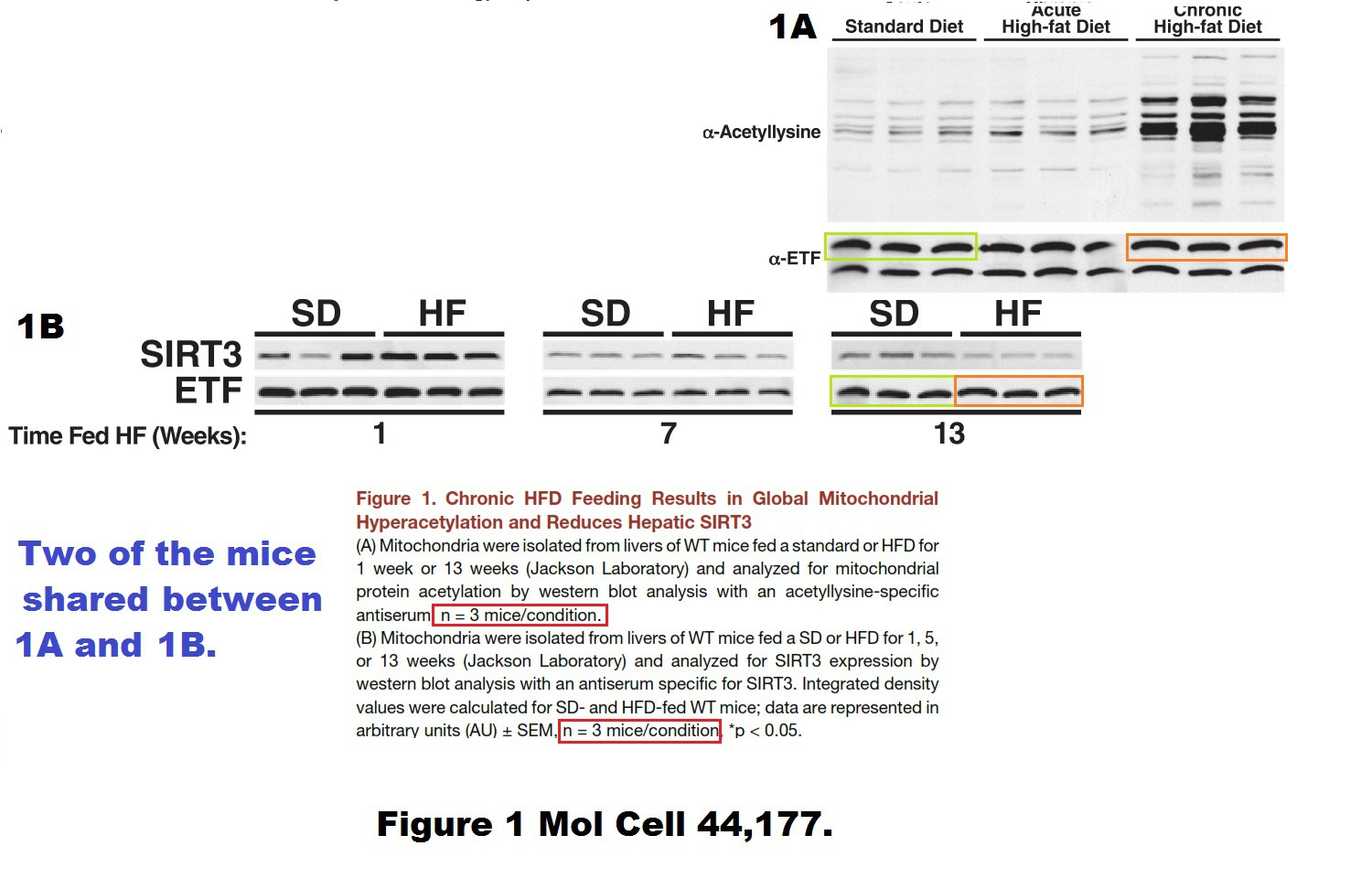
As it happens, Verdin is Board of Directors member of the Californian anti-aging biotech named Edifice Health. He also sits on the advisory board of a Belgian anti-aging company Genflow Biosciences which sells a viral gene therapy targetting SIRT proteins. Together with another questionable Belgian, Johan Auwerx, Verdin also sits on the advisory board of George Church’s anti-aging company Rejuvenate Bio. Which last year announced to sell anti-aging drugs to dogs (read earlier Friday Shorts).
Long-term consequences for our bodies
Elsewhere in the anti-aging research, Kiwi scientists figured out that the smell of your wife makes you grow old. A press release by the University of Otago announced “Shocking New Research“:
“Lead author Associate Professor Mike Garratt, of the Department of Anatomy, says research has previously shown interactions with the opposite sex can speed up aging. This study has built on that by showing sensory cues alone can drive those effects. […]
The researchers found males exposed to female olfactory cues, or chemical smell signals, from middle to old age had reduced fertility later in life. Males exposed to female odors in conjunction with mating also showed an increased mortality rate. […]
“It is known that sensory cues influence the release of hormones that can have short-term physiological effects on animals and humans. These effects can conceivably ‘add up’ and extend to influence our health. We should think about the environment that we live in, how we perceive it, what feelings it elicits, and take note of this as this could have long-term consequences for our bodies,” he says.”
This is the groundbreaking paper:
Michael Garratt, Heather Try, Christine Neyt and Robert C. Brooks, “Exposure to female olfactory cues hastens reproductive ageing and increases mortality when mating in male mice” Proceedings of the Royal Society B. (2024) DOI: 10.1098/rspb.2023.1848
Stay away from women, lads. Their smell will literally bring you into your early grave.
I thank all my donors for supporting my journalism. You can be one of them!
Make a one-time donation:
I thank all my donors for supporting my journalism. You can be one of them!
Make a monthly donation:
Choose an amount
Or enter a custom amount
Your contribution is appreciated.
Your contribution is appreciated.
DonateDonate monthly
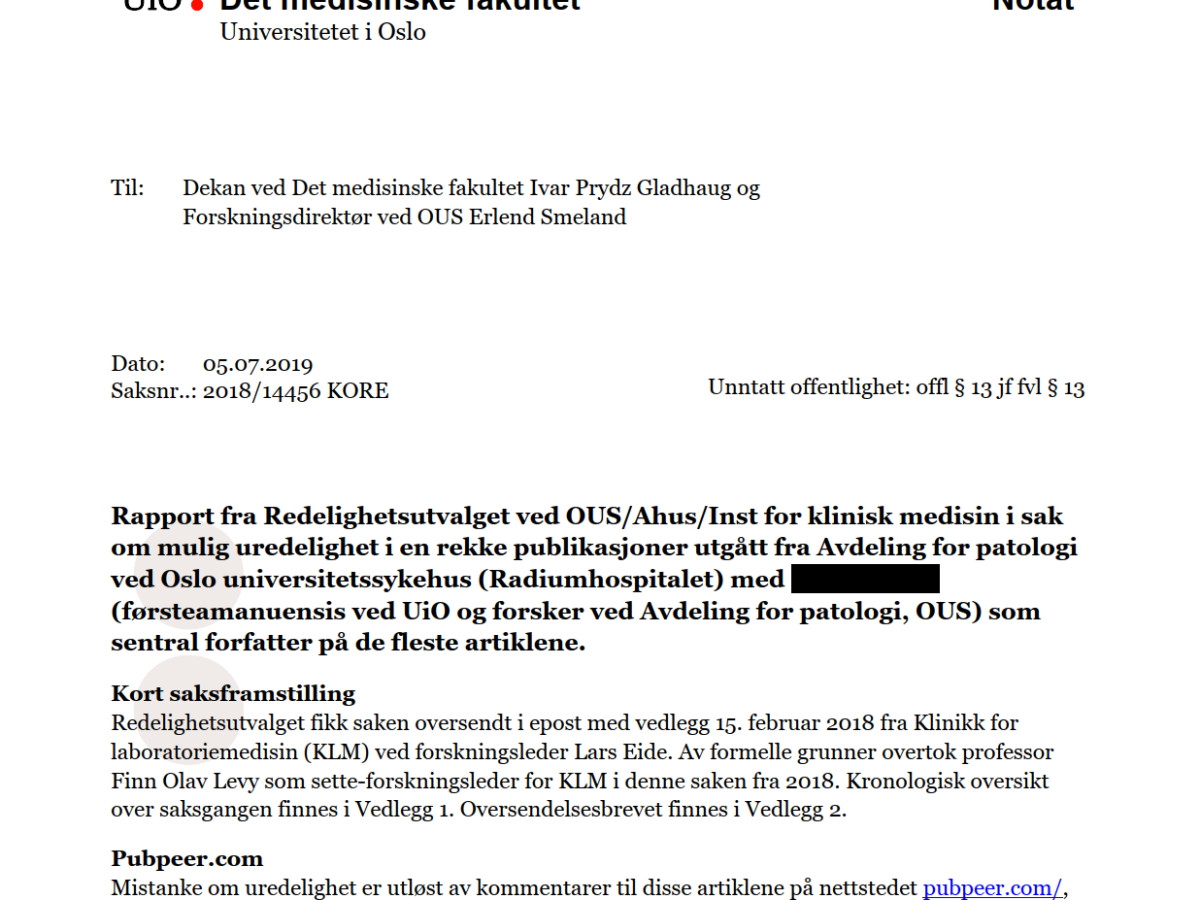










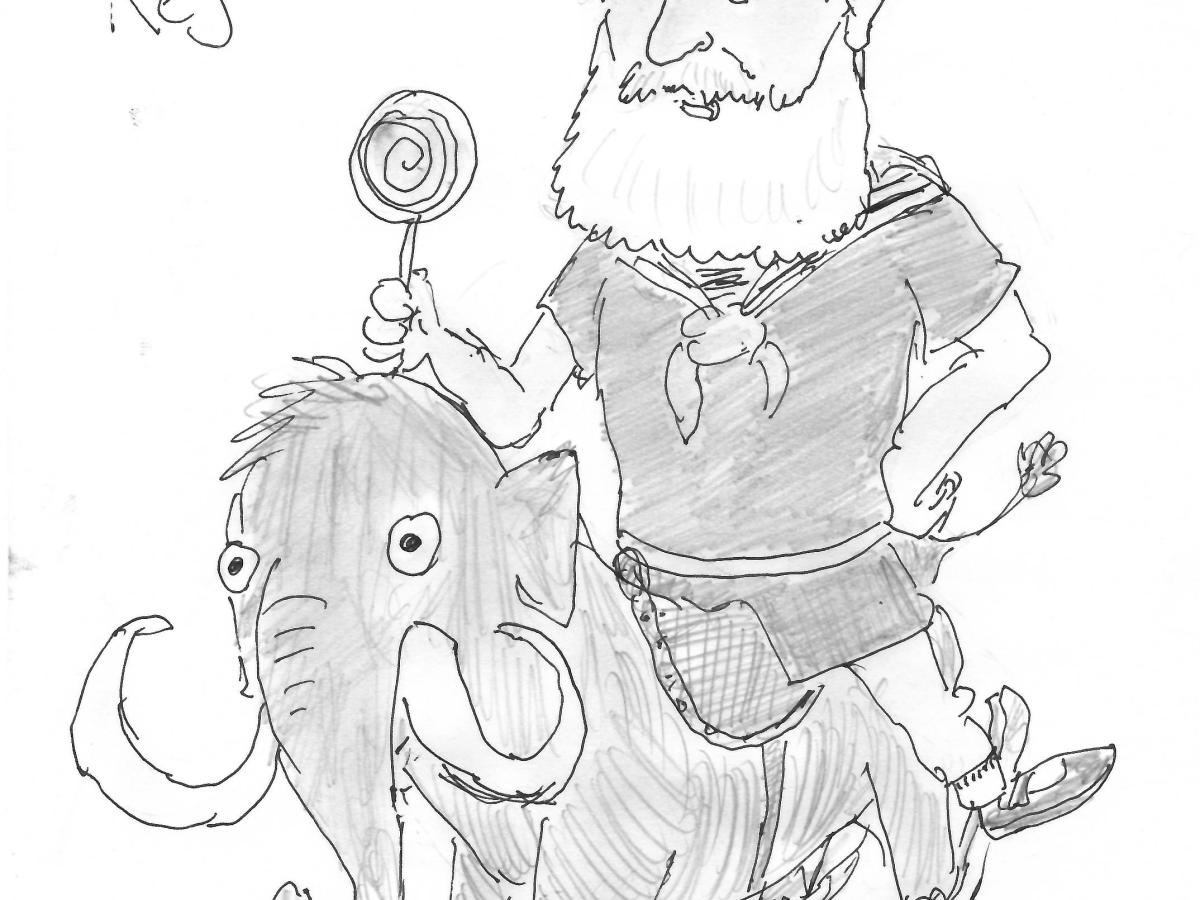




Shouldn’t we just stay away from the smell of female mice?
LikeLike
This student is only 21 years old.
https://media.gettyimages.com/id/820472982/photo/laboratory.jpg?s=612×612&w=gi&k=20&c=Xo4sA3d7fHexVNOCwQR7pkPABWHhWK_jQCrrpD07U-s=
LikeLike
Regarding Jhamandas, middle author on one of the papers looked familiar – David Westaway had a few papers featured on my site back in 2012 (subsequently added to PubPeer)…
https://pubpeer.com/publications/41D213789D91CC52523017B86D15C7
https://pubpeer.com/publications/6946746E481307DA19110EBB5EA3DA
https://pubpeer.com/publications/4D27D48E46EB074447D7070C60EADA
Also regarding dog aging, Kaeberlin’s take-down of Sinclair might be somewhat related to the fact that his former mentee Celine Halioua went off to found a company doing exactly the same thing (https://loyalfordogs.com/). It’s one thing to call Sinclair a charlatan, but something else when one is themselves knee-deep an anti-aging biotech startups (see also Brenner, constantly ragging on Sinclair while suing over patents related to NAD+ and selling NAD+ boosting supplements – https://www.truniagen.com/).
LikeLike
I am searching for investors for my Cat Rejuvenation start-up. We will use resveratrol, rapamycin, roscovitine, spermidine, stem cells, vitamins, stool microbiome and young blood. All mixed with cat food and force fed
LikeLike
Yes but which of a cat’s nine lives will you be targeting? I’d aim for the first one so if it ends up killing them nobody will notice because there’s another eight left.
Hey – idea for your company name – 10 lives!
LikeLiked by 2 people
Thanks for joining the 10 LIVES advisory board! I will also check with Louis Ignarro.
LikeLike
Don’t miss out on the senolytics!
1. Arrest the cell cycle with Roscovitine.
2. Clear arrested cells with Dasatinib, Quercetin, Fisetin or Navitoclax.
3. Media campaign
4. Profit
LikeLike
Maybe I will call my biotech Confuse-A-Cat Ltd
LikeLike
I’ll bring several Schroedinger’s cats.
LikeLiked by 1 person
Raw material for exosome-driven rejuvenation is cheap and abundantly available! It’s almost like winning the lottery… if the lottery were for bio-rejuvenation supplies.
Extracellular vesicles from human urine-derived stem cells delay aging through the transfer of PLAU and TIMP1
https://www.sciencedirect.com/science/article/pii/S2211383523004768
$$$!
LikeLike
An Anti-aging Clinic where they piss you in your face.
LikeLike
Hi Paul: Looking at Westaway papers was what brought Jhamandas to my attention.
LikeLike
Didi I see George Church mentioned?
Uncanningly, the German Statepress ‘reports’ today:
https://www.tagesschau.de/wissen/forschung/mammut-forschung-100.html
Ice Age giant
Are researchers bringing back the mammoth?
Status: 22/03/2024 12:10 pm
Mammoths have been extinct for thousands of years. A start-up from the USA wants to change this, and now an important milestone seems to have been reached. Can the scientific breakthrough succeed?
By Leander Beil, BR
Researchers from the US company Colossal Biosciences have succeeded in producing elephant stem cells for the first time. Firstly, this lays the foundation for the biotechnological breeding of elephants. And secondly, it could potentially be used to create elephants with the characteristics of woolly mammoths…
LikeLike
I pay for this journalism…
LikeLike
You’re forced to pay for it!
But when your Confuse-A-Cat Ltd. makes its first gazillion dollars, you won’t mind anymore. Statepress will even kiss your ass and ‘print’ whatever your PR Team makes up.
LikeLiked by 1 person
Darren J Burgess,
Senior Editor: Nature Springer, Nature Group
https://uk.linkedin.com/in/darren-burgess-83532123
is on this paper.
https://pubpeer.com/publications/22A0D80CF891EEFEB7C23332484780
The paper is a Cell stable journal, so it doesn’t matter to Nature Springer, or the Cell stable either.
LikeLike
Yu-Tzu T. – Associate Director – ADC & Translational Research at Oxford BioTherapeutics | The Org
Yu-Tzu T. has extensive work experience in the field of cancer research and therapeutics. They most recently worked as an Associate Director of ADC & Translational Research at Oxford BioTherapeutics, starting in 2022.
Prior to that, they served as a Principal Scientist at the Dana-Farber Cancer Institute from 2017 to 2022. They also held the position of Sr. Research Scientist at the Dana-Farber/ Harvard Comprehensive Cancer Center from 2009 to 2017. From 2000 to 2009, they worked as an Instructor at the Dana-Farber Cancer Institute. Yu-Tzu T. began their career in cancer research as a Postdoctoral Research Associate at Harvard Medical School and the Dana Farber Cancer Institute from 1996 to 2000.
6 retractions (first 3 as first author):-
Retraction: Ku86 Variant Expression and Function in Multiple Myeloma Cells Is Associated with Increased Sensitivity to DNA Damage – PubMed (nih.gov)
Retraction: Mechanisms by which SGN-40, a Humanized Anti-CD40 Antibody, Induces Cytotoxicity in Human Multiple Myeloma Cells: Clinical Implications | Cancer Research | American Association for Cancer Research (aacrjournals.org)
Retraction: Insulin-like Growth Factor-1 Induces Adhesion and Migration in Human Multiple Myeloma Cells via Activation of β1-Integrin and Phosphatidylinositol 3′-Kinase/AKT Signaling – PubMed (nih.gov)
Retraction: Nuclear Factor-κB p65 Mediates Tumor Necrosis Factor α-induced Nuclear Translocation of Telomerase Reverse Transcriptase Protein – PubMed (nih.gov)
Retraction: Effects of Oligonucleotide N3’→P5′ Thio-phosphoramidate (GRN163) Targeting Telomerase RNA in Human Multiple Myeloma Cells – PubMed (nih.gov)
Retraction: Cytokines Modulate Telomerase Activity in a Human Multiple Myeloma Cell Line – PubMed (nih.gov)
Editor’s Note.
Editor’s Note: Targeting Akt and Heat Shock Protein 90 Produces Synergistic Multiple Myeloma Cell Cytotoxicity in the Bone Marrow Microenvironment – PubMed (nih.gov)
LikeLike
I think it is important to remind you that because Dr. Yu-Tzu has proven himself VERY successful as he has an important position in an American company and is presumably making a LOT more money than you, he is NOT a failed scientist. Everything went as well as could be hoped for this inspiring aspirational immigrant.
LikeLike
I think that Yu-Tzu Tai is a she, but I am old-fashioned.
“Everything went as well as could be hoped for this inspiring aspirational immigrant.”
Yes, in the U.S. and now in the U.K..
LikeLike
Our loss is your gain! Enjoy him (her?) !
LikeLike
That’s because a professorship at DFCI was denied. I wonder why.
LikeLike
A once-ignored community of science sleuths now has the research community on its heels (nbcnews.com)
“Today, scientific journals have entire teams dedicated to dealing with images and trying to ensure their accuracy.”
I don’t believe that. Most just have email addresses of research integrity teams, but no teams, or teams to prevent research integrity.
LikeLike
The community, according to NBC, consists of exactly two people. Elisabeth Bik and Sholto David.
You others don’t exist.
LikeLike
As to your question about the Internet in Canada. We are the original power users, having always ranked at the top of stats for the proportion of population online. Makes sense, as Canada is a big country with lots of isolated outposts, like Edmonton.
LikeLike
Yeah, I didn’t seriously fall for Jack’s fairytales
LikeLike
Regarding the Figure 5 of doi:10.1152/jn.2001.86.3.1312 (Jhamandras’ paper), the areas indicate on the figure in red/orange/yellow do not look identical at all. The gel might be fake, but I’m not seeing it.
LikeLike
The claim is “unexpectedly similar”. The claim is not that they are identical.
LikeLike
How mmuch of mice sciences is actually useful? Is there something or the whole field is just a public money theft scheme?
LikeLike
Fuel publishes papermill garbage non-stop: https://docs.google.com/spreadsheets/d/1IUulPjUgR9Wt7A5ng-Yfs84kUUnJ2rWFbmmlny2cPso/edit#gid=0
LikeLike
See https://archive.ph/2024.03.22-234132/https://www.nrc.nl/nieuws/2024/03/22/hoe-ronald-plasterk-miljonair-werd-en-de-universiteit-had-het-nakijken-a4193871 for backgrounds about activities of Ronald Plasterk [in Dutch].
LikeLike
One of the fuel articles got a correction: https://www.sciencedirect.com/science/article/pii/S0016236124007087
You can’t make this shit up, it is just the same , but with some small changes. WTF is happening at fuel???
LikeLike